1lumen selects and reviews products personally. We may earn affiliate commissions through our links, which help support our testing.
Fenix PD36R V2.0 review
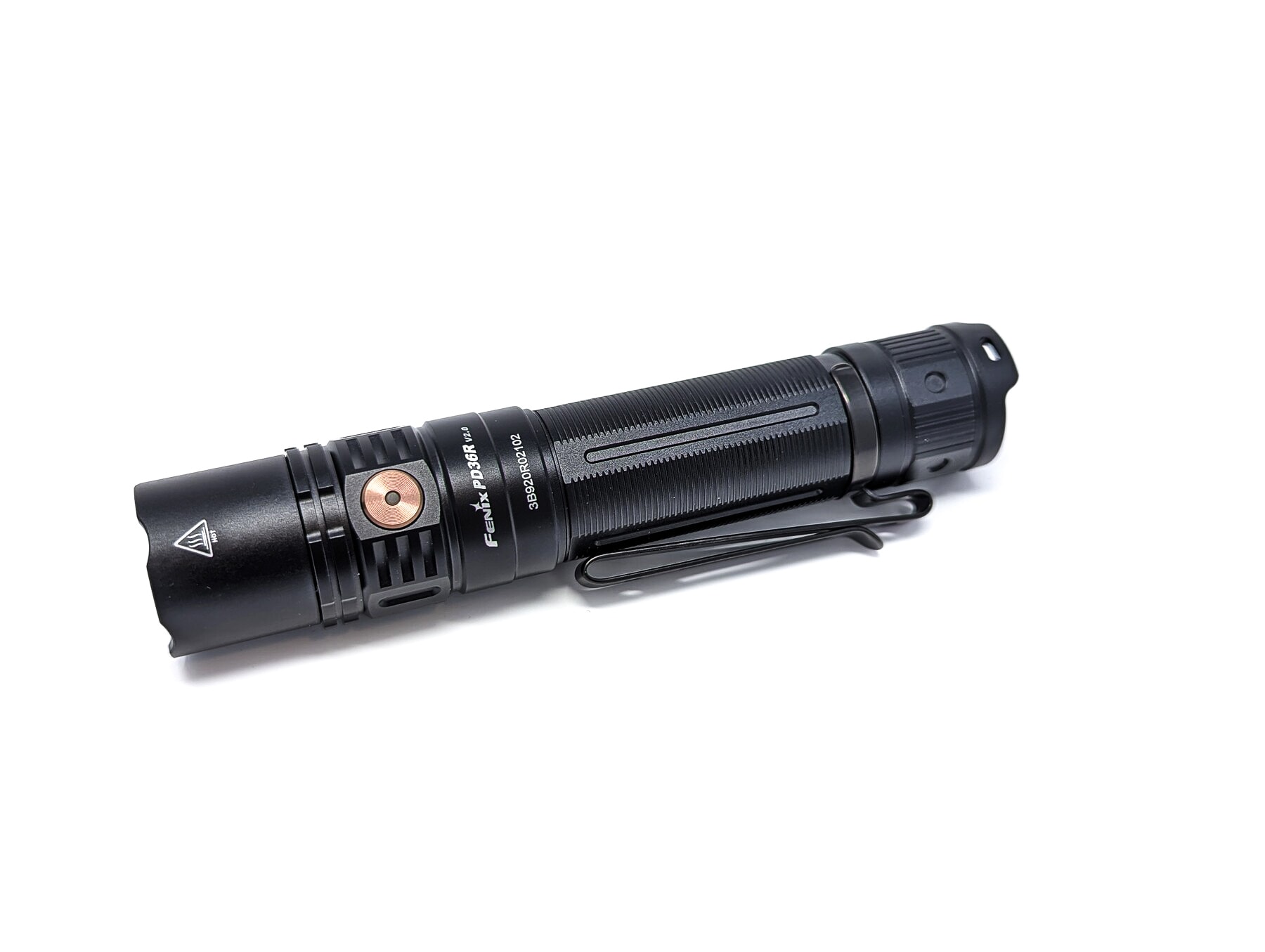
Fenix PD36R V2.0 specs
| Brand & Model | Fenix PD36R V2.0 |
|---|---|
| Flashlight category | Tactical |
| LED | Luminus SFT40 |
| Max. output | 1,700 lumens |
| Max. beam distance | 396 meters |
| Max. beam intensity | 39,240 cd |
| Battery config. | 1x 21700 |
| Onboard charging | USB-C |
| Main modes | 5 |
| Blinkies | Strobe |
| Waterproof | IP68 |
| Review publication date | December 2023 |
Review intro:
Fenix makes a huge array of lights. In fact, they have an actual PDF catalog on their website (I imagine it’s probably also distributed in paper form as well) that is 48 pages long and chock-full of products ranging from tiny EDC lights all the way up to a couple really big boys that I’ve been fortunate enough to check out: the LR50R 12,000 lumen monstrosity and the HT30R 1500m throw LEP. If you need a light, chances are that Fenix will have a nice offering to fill that need.
By and large, I really like Fenix – my first “real” flashlight was a Fenix (the 187 lumen E25 model, if you’re curious). From my experience, Fenix lights are really well designed, they use quality materials and finishes, have great constant-current drivers, and publish truthful ANSI specs. I recently reviewed the small Fenix LD12R dual-LED EDC light and the hunting-focused Fenix HT32, which were both very nice entries in the lineup.
This new flashlight is the PD36R V2.0. As the naming would imply, this isn’t the first PD36 model, but it’s also not the 2nd – even if it is labelled V2.0. This is at least the 5th PD36 model. The original PD36 relied on the battery’s port for charging. The PD36 TAC had a unique “tactical” tailswitch. The PD36R went back to a more standard switch configuration, but moved the charging circuitry to the flashlight itself. And then Fenix released the Fenix PD36R Pro, which I have reviewed, which increased both the lumens and intensity, as well as moving the e-switch to the tail (dual tail switches). The PD36R V2.0 is more of an upgrade to the PD36R than it is a replacement for the PD36R Pro, as it goes back to the e-switch being located on the head of the flashlight and bumps up the intensity. Now that we have the family history down, let’s dive into the review, shall we?
Before starting with the Fenix PD36R V2.0, make sure to remove the battery isolation disc!
Package quality.
The packaging for the Fenix PD36R V2.0 is instantly recognizable as having come off the same line as the other Fenix models that I recently reviewed. They used the exact same design language and materials: a showy black and orange carton with a heavy duty plastic tray inside. I think it’s great that Fenix is using consistent packaging as it helps drive brand recognition. Arranged in the tray was:
- Fenix PD36R V2.0
- Battery
- Charging cable
- Spare o-ring
- Holster
- Pocket clip (pre-installed)
- Lanyard
- Manual and other literature
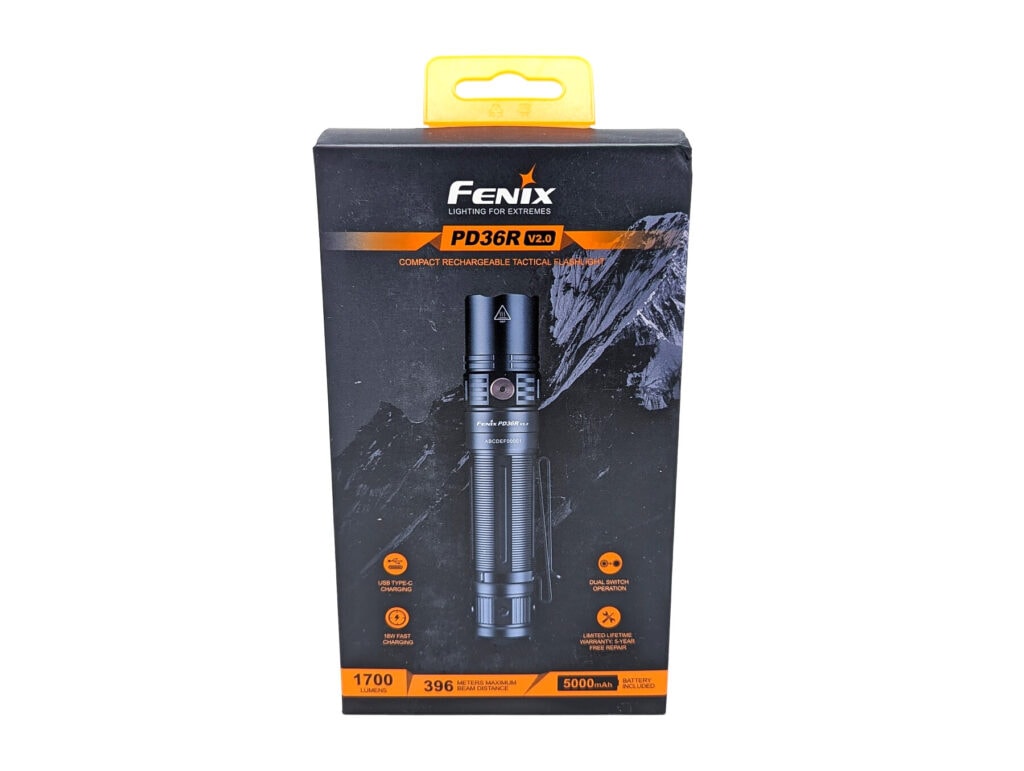
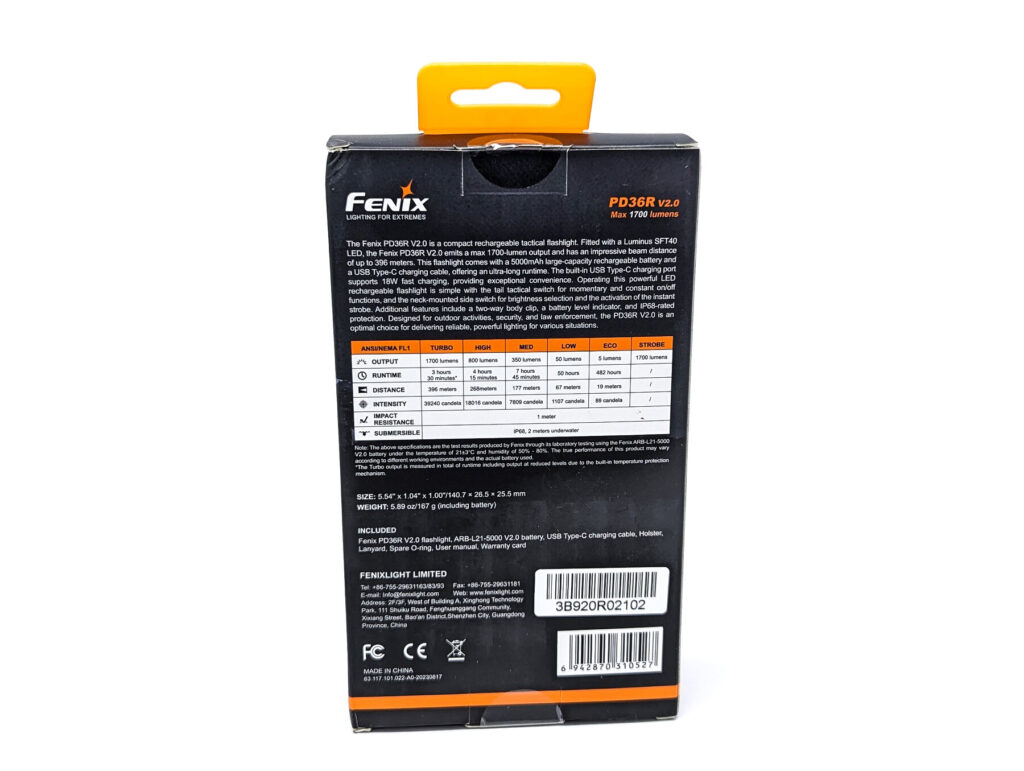
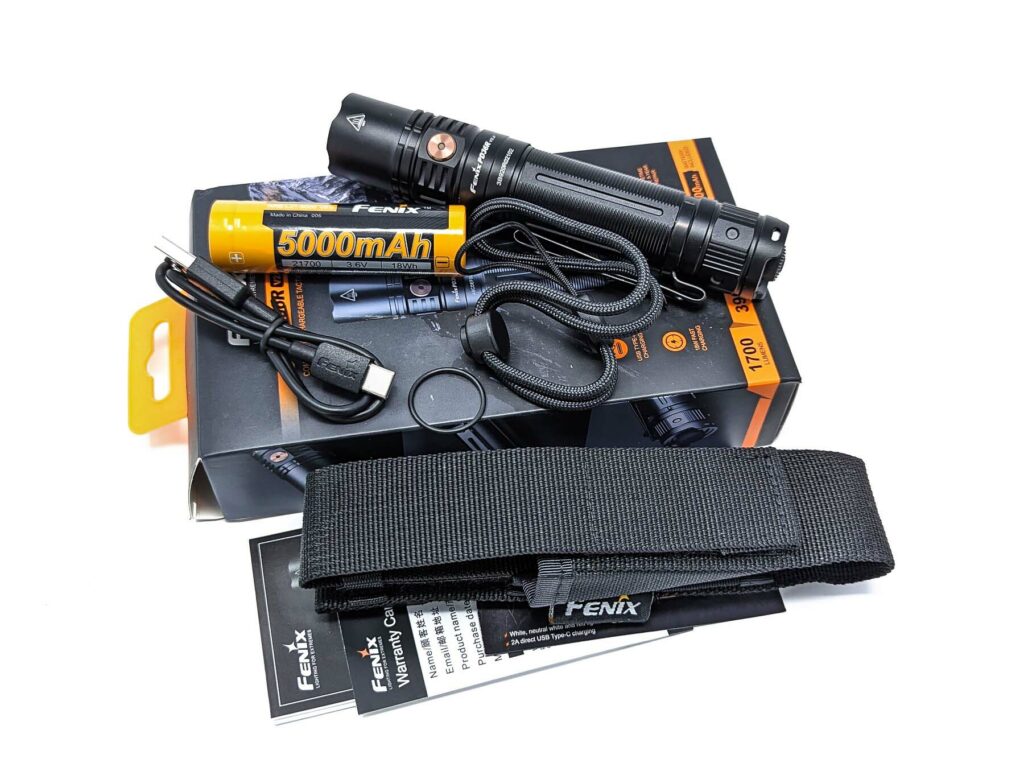
Flashlight in use, Build Quality, and Warranty
Size-wise, I consider the PD36R V2.0 to be very comfortable to hold and operate. I feel like 21700 lights strike a nice, happy medium on sizes and overall sit in the hand pretty well even if they tend to be too big for EDC carry. In terms of carry, the Fenix PD36R V2.0 comes with a pocket clip preinstalled. The clip is very firmly attached and should work well, though I can’t see pocket-carrying the PD36R V2.0 too often – it’s on the large side of lights that I would stow away in my pocket unless I really knew I was going to need it. Fenix included a lanyard that is a small step above your average flashlight lanyard – it is embossed with the Fenix logo and it has an adjustable bead for cinching the lanyard down. Lastly, Fenix also threw in a fabric holster for this light. The holster seems to work well and would probably be my preferred carry method if I wanted the PD36R V2.0 with me frequently.
The Fenix PD36R V2.0 has two switches, and, unlike the PD36R Pro, one switch is on the tailcap and one is on the head of the flashlight. The tail switch is a clicky on-off switch that also provides momentary activation. The second is a copper-colored button, it’s an e-switch on the head of the light that is used for switching modes. The side switch is pretty flat and can take a second to find when you’re not visibly looking at it. Due to the tail switch protruding from the end of the light, this light does not tail-stand.
First and foremost, I see the PD36R V2.0 as a professional/duty light. Since there is mode memory and no way to instantly activate Turbo or Strobe, I wouldn’t call this a tactical light. The beam is pretty throwy, so it does make a good searchlight – something to scan a parking lot, field, or backyard with. But you could just as easily use it hunting, hiking, or when something goes bump in the night.
As far as construction goes, we’re looking at A6061-T6 aluminum, which is typical as far as flashlights go. Fenix then coated it with a premium Type III hard-anodization. There’s a lot of machining on this light, and to be honest it does look a little busy. All in all, though, it is well executed and seems high quality – exactly what I expect of a reputable brand like Fenix.
Warranty:
- 15 days from date of purchase: replacement from Fenix for manufacturing defects
- 5 year from date of purchase: free repairs
- Lifetime maintenance, with customer covering the cost of parts
- Extra 6 month warranty period for products registered on Fenix’s website
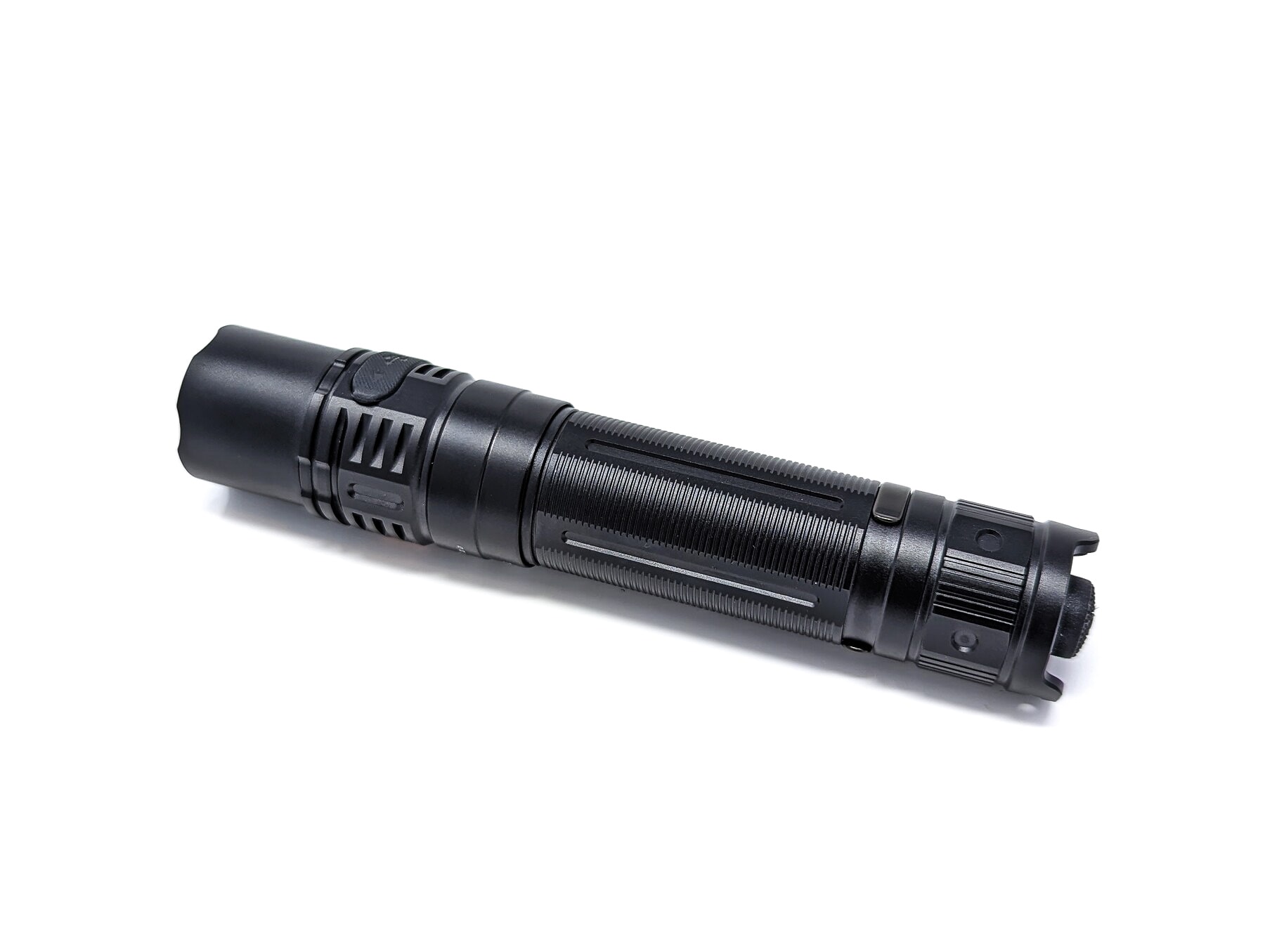
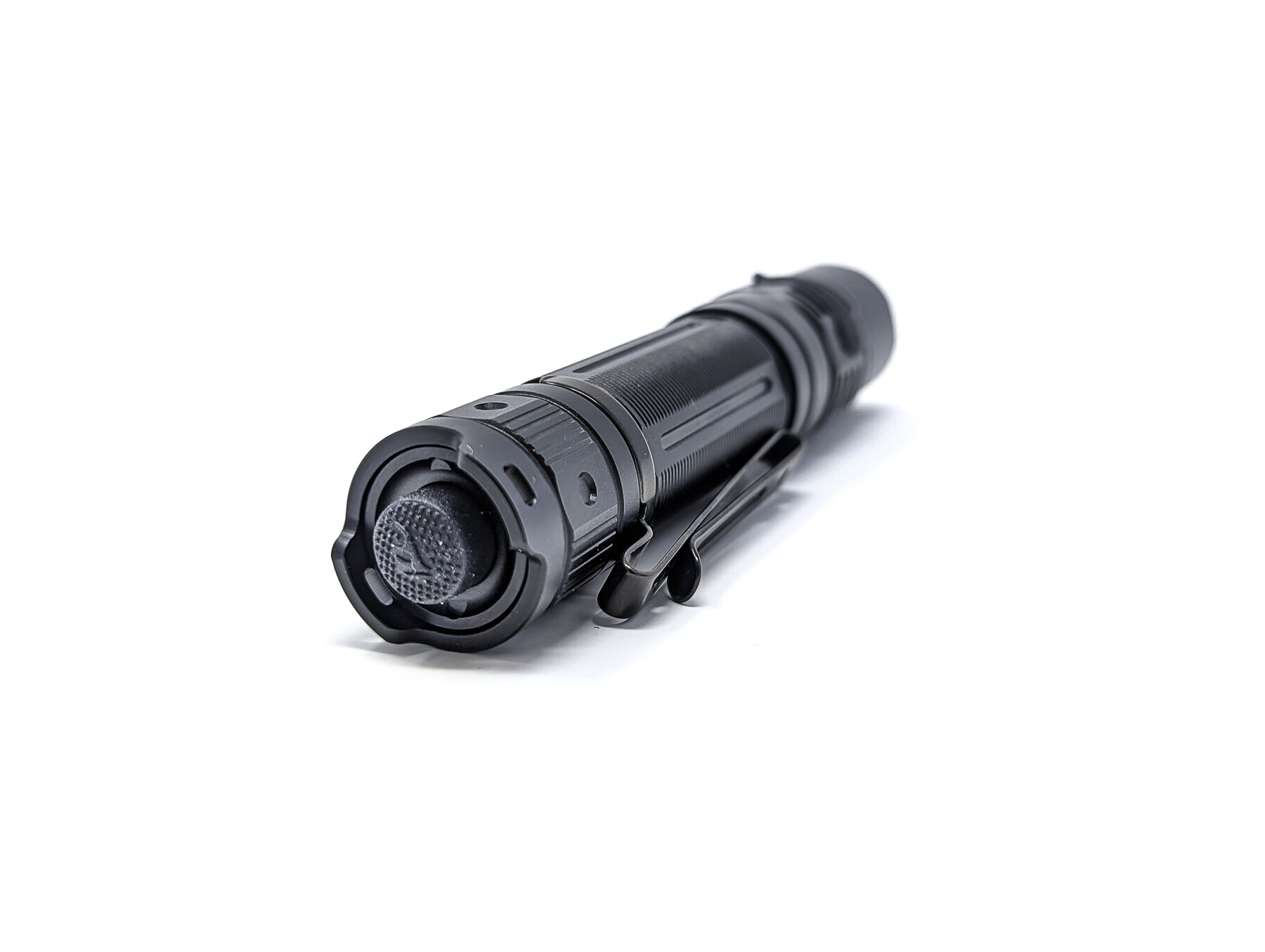
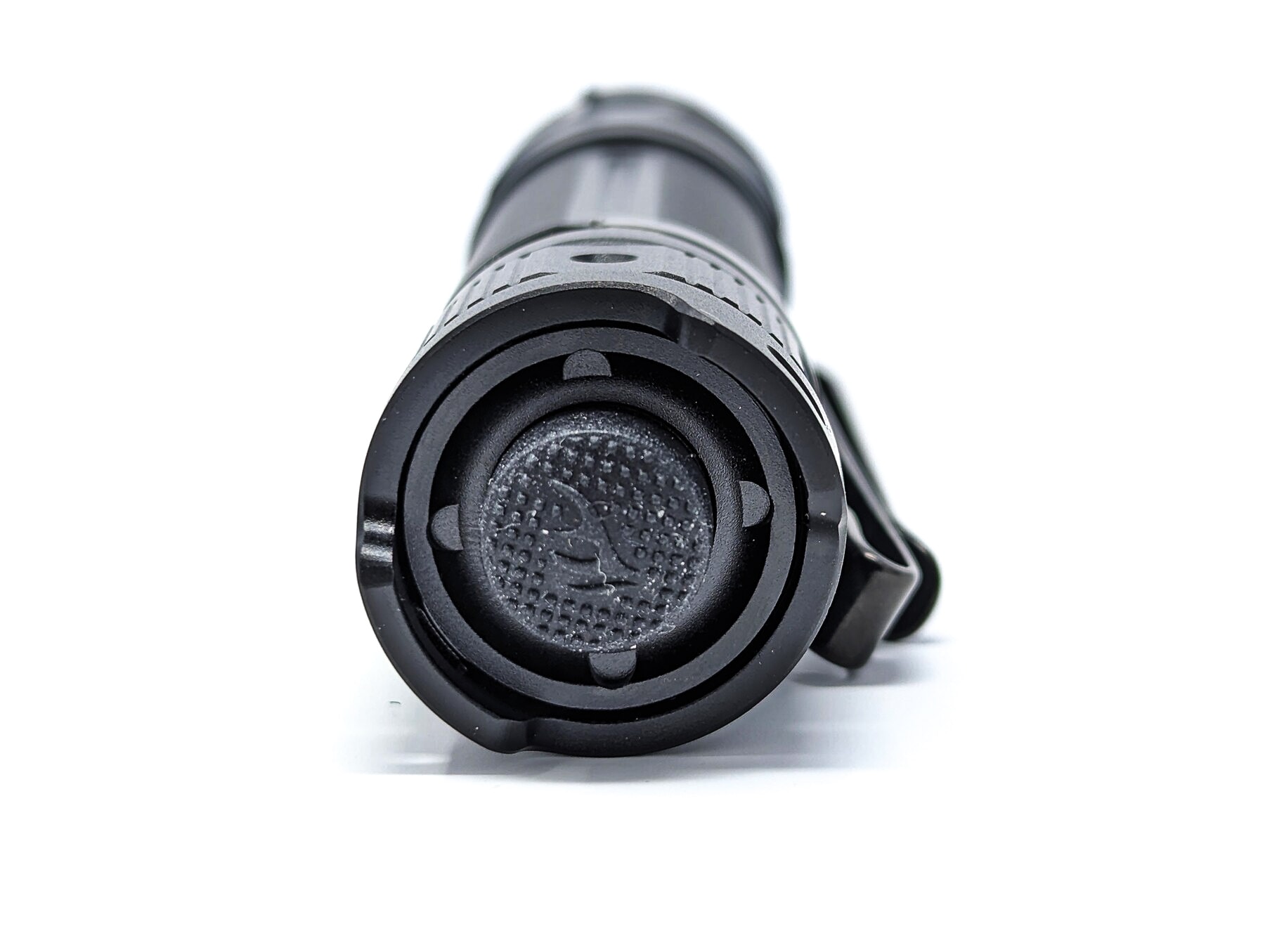
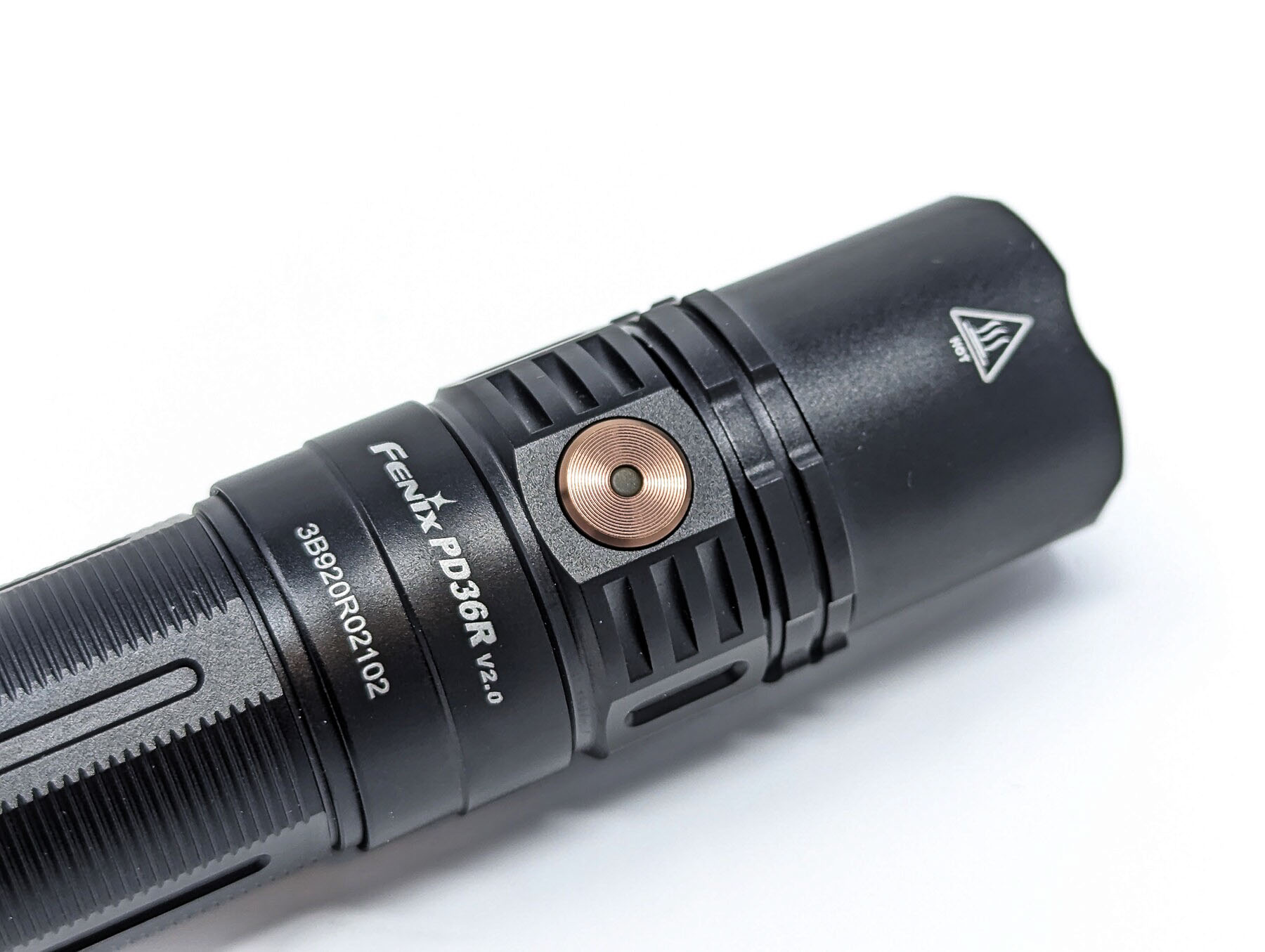
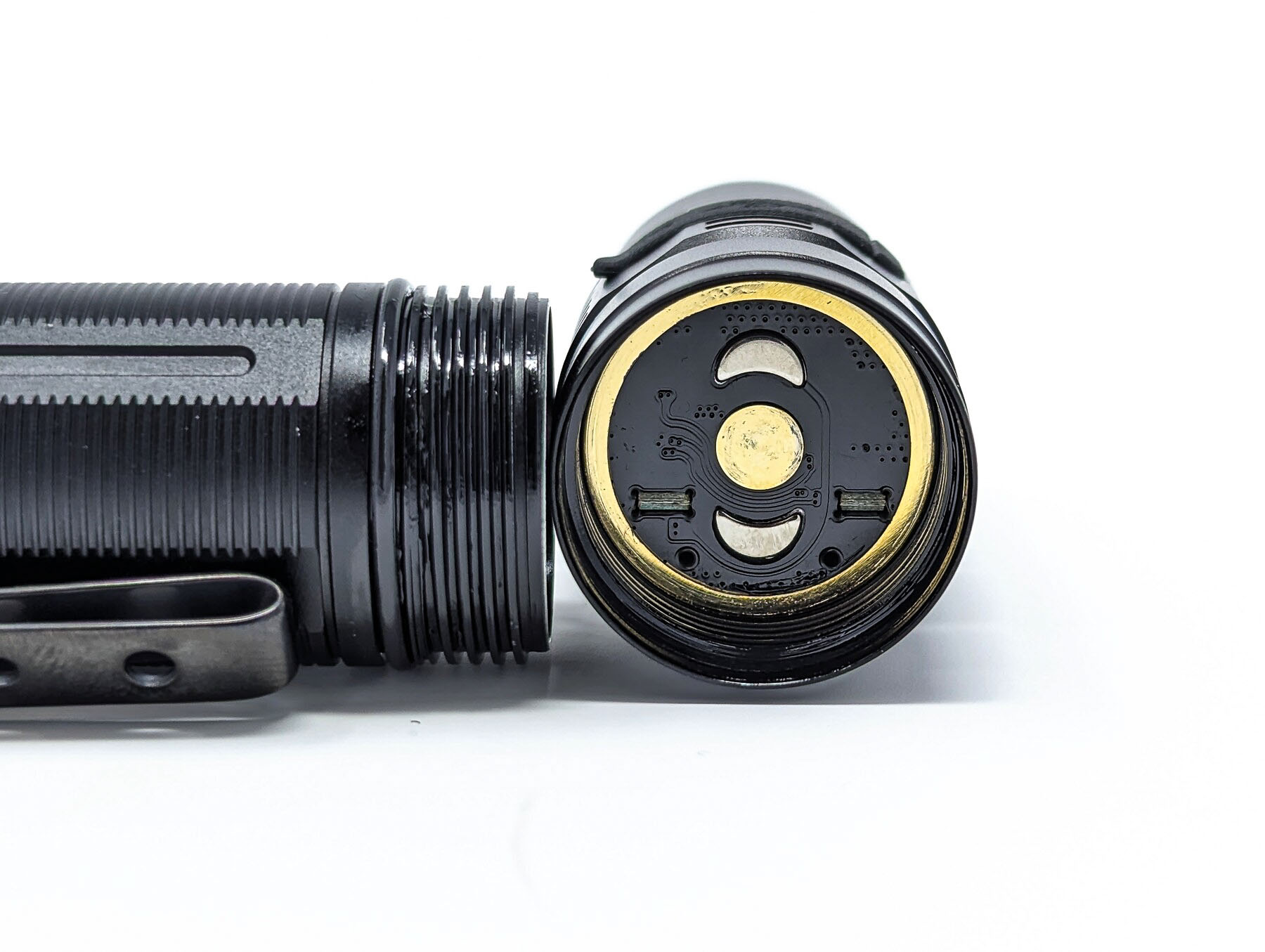
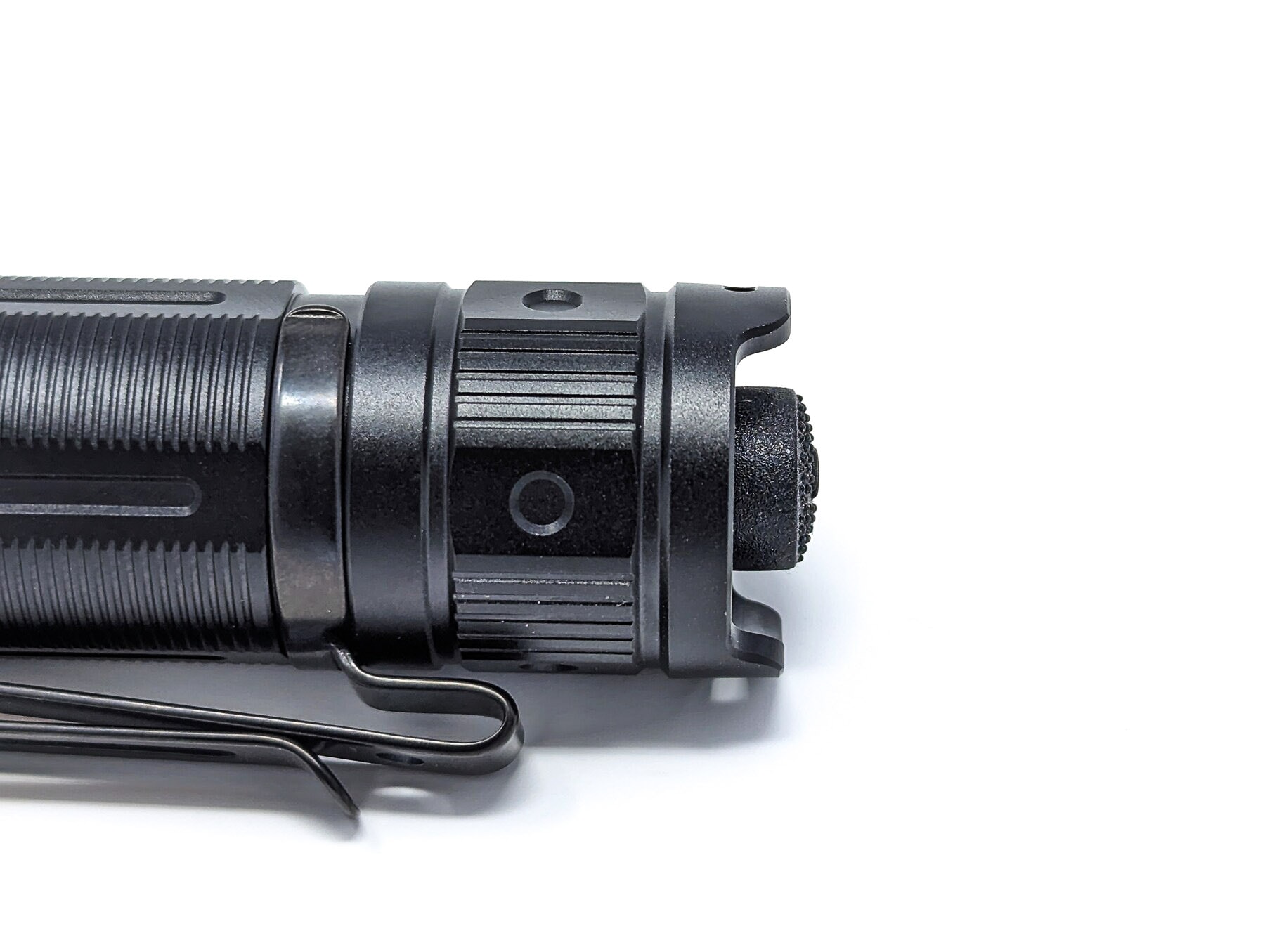
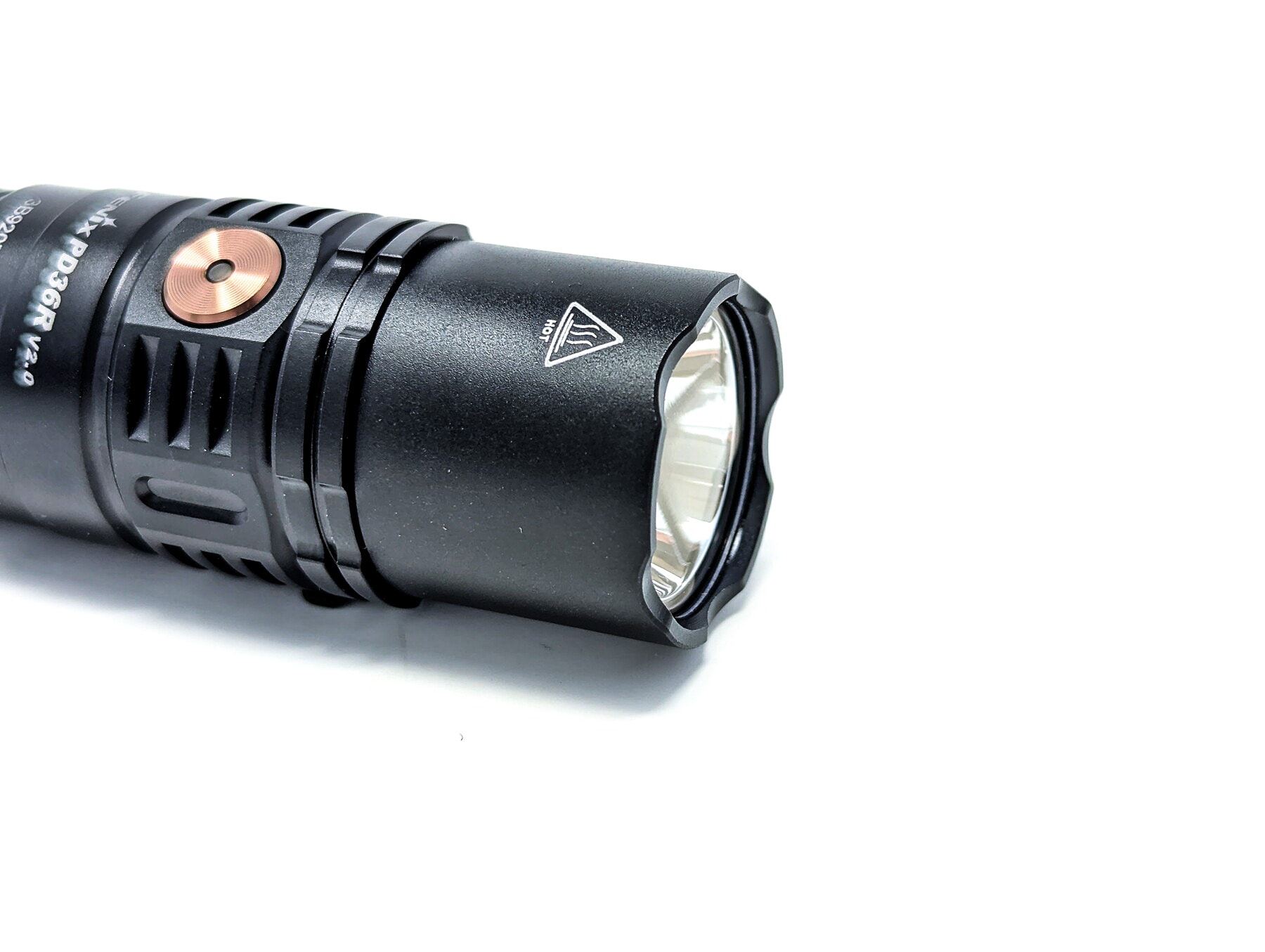
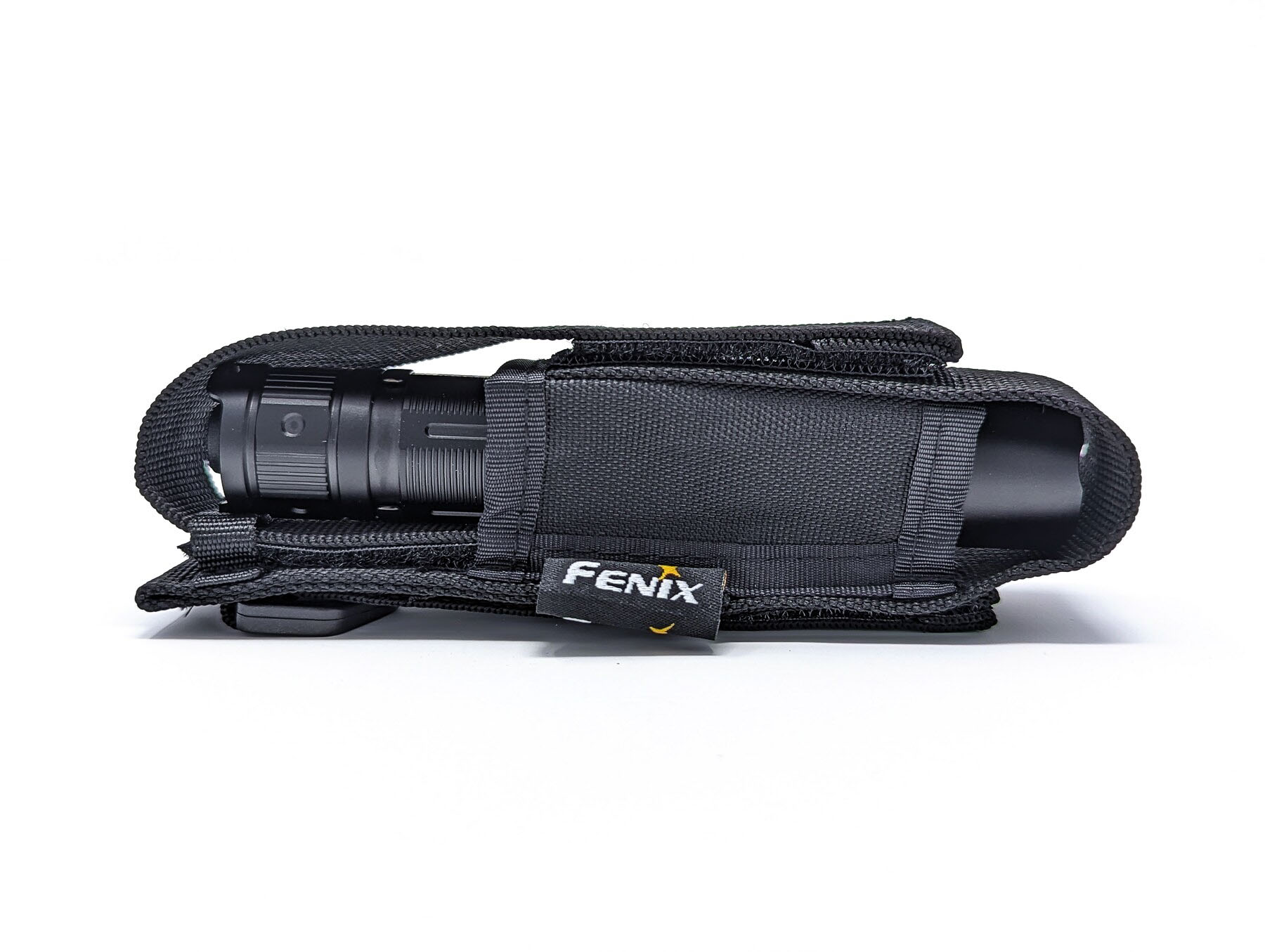
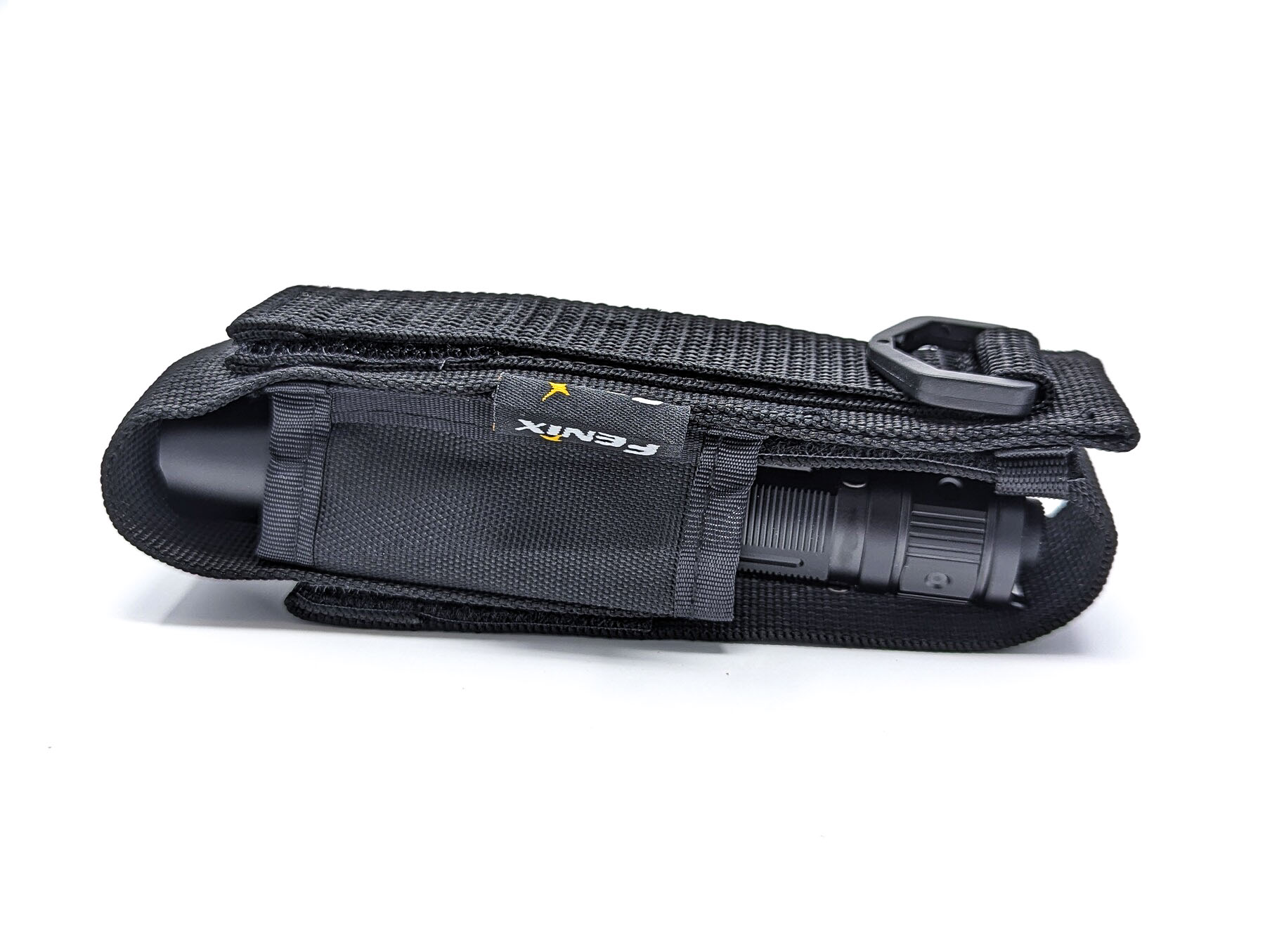
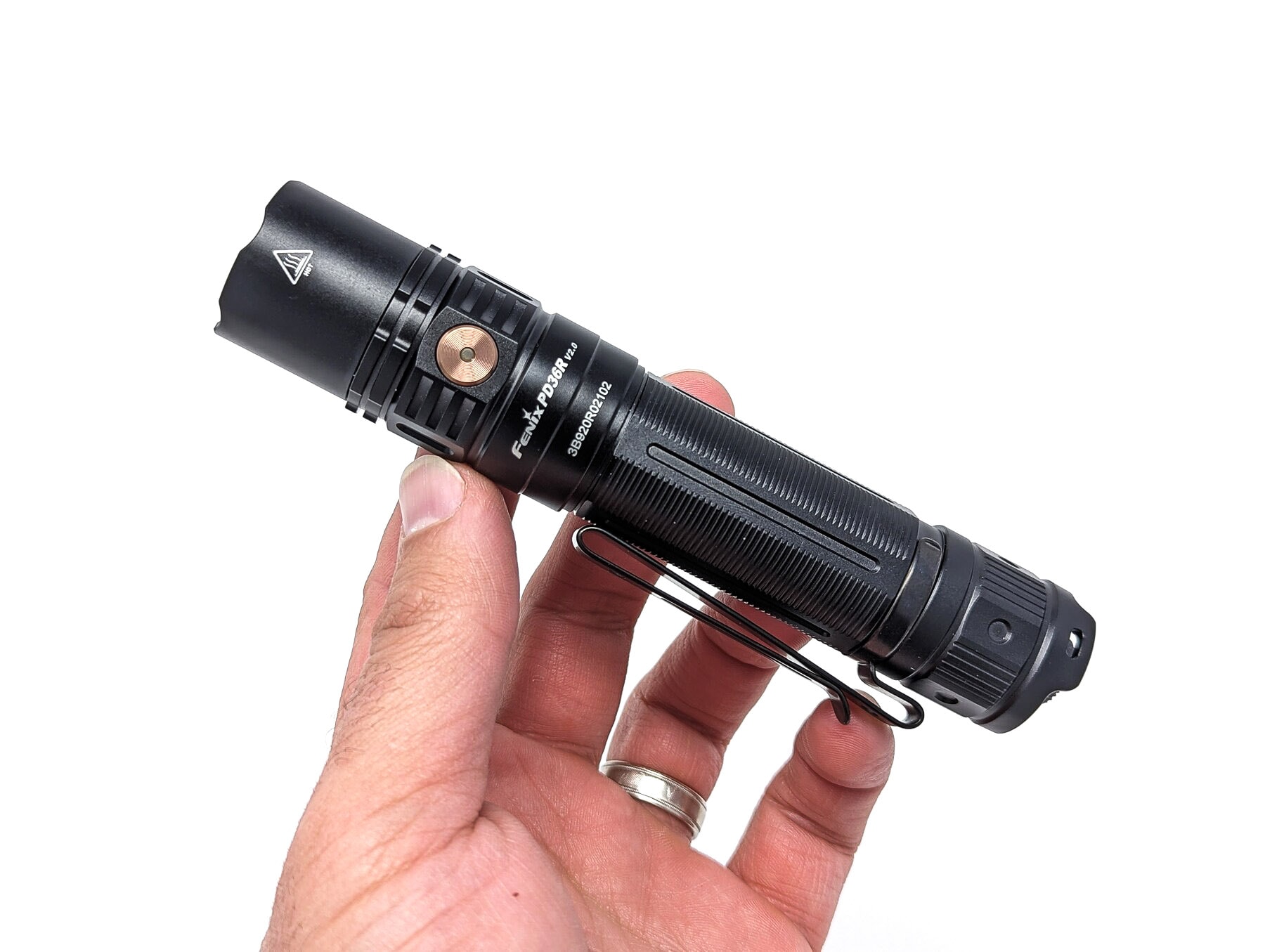
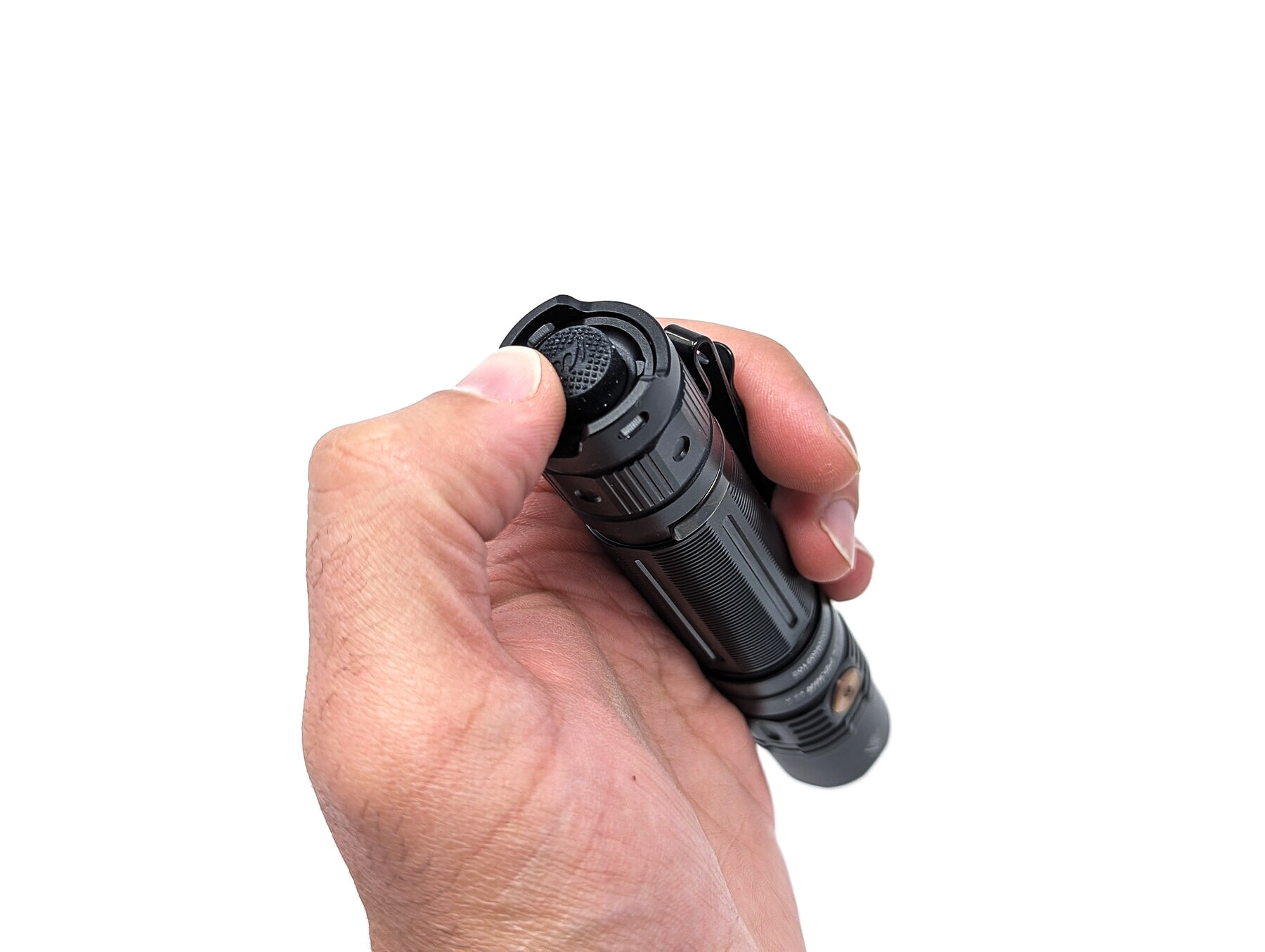
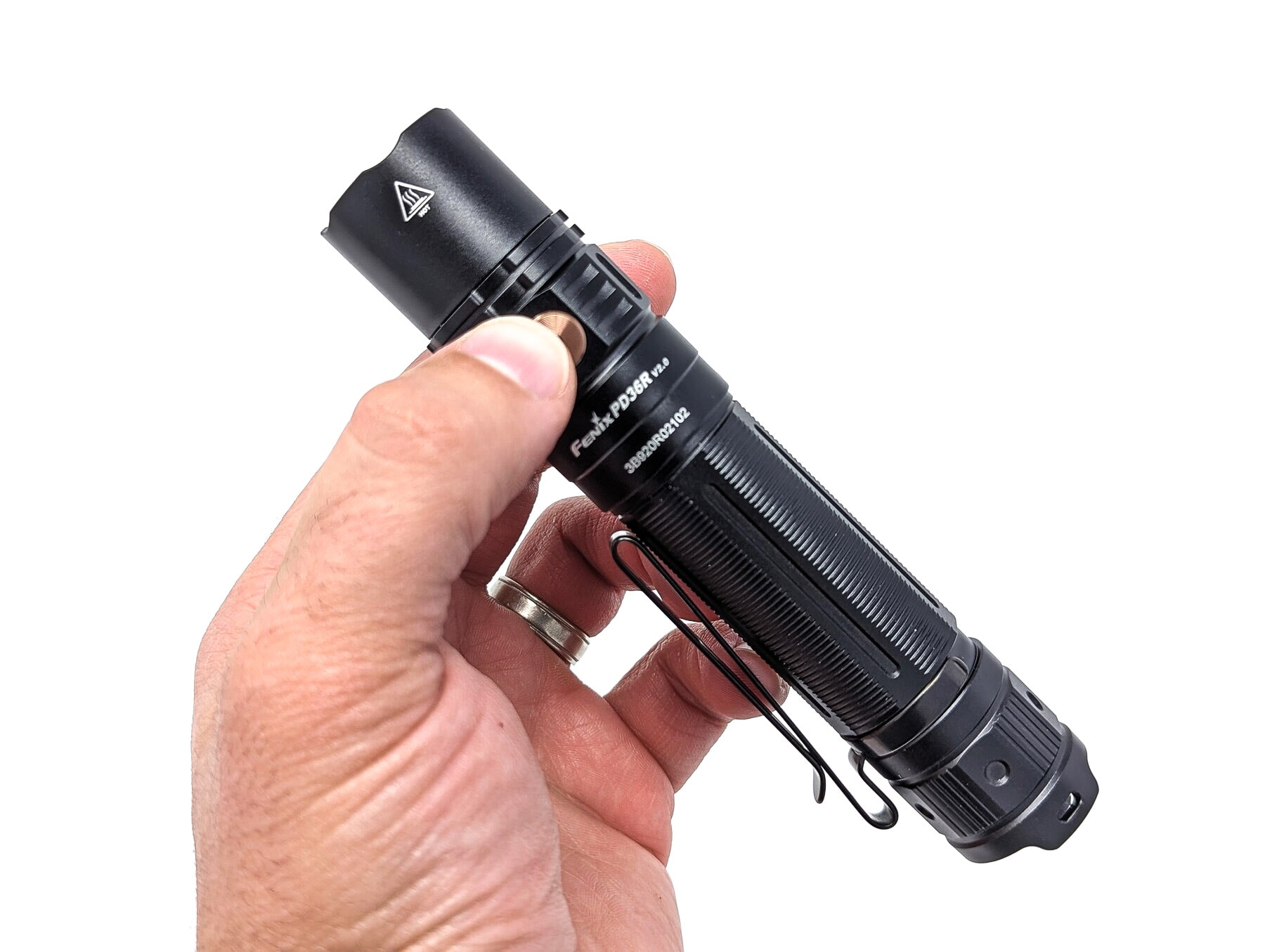
LED, Lens, Bezel, Beam, and Reflector
Fenix went with the Luminus SFT40 LED for the PD36R V2.0. This is a domeless LED that has been reasonably popular lately, and for good reason – it’s durable, powerful, high-efficacy, and has a clean, intense beam. The SFT40 is nicely centered in a mid-size, smooth reflector to make a throwy beam. There’s a tight hotspot that is good for reaching out to distances (well, for a tube light that is), a defined largish mid-corona, and a mildly large spill. The beam is clean, free from wild tint shifts, and is fairly neutral tinted for being a cool white emitter – there’s no obvious green or blue hues, at least according to my eyes.
The reflector and LED are protected by a sheet of anti-reflective coated glass. The glass is held in place by the aluminum bezel, which has a lightly crenulated / scalloped edge.
Spectral measurements:
I used an Opple Light Master to measure the flashlight at 5 meters distance.
| Mode: | CCT: | CRI Ra: | duv |
|---|---|---|---|
| Turbo | 6439 K | 68.1 | +0.0040 |
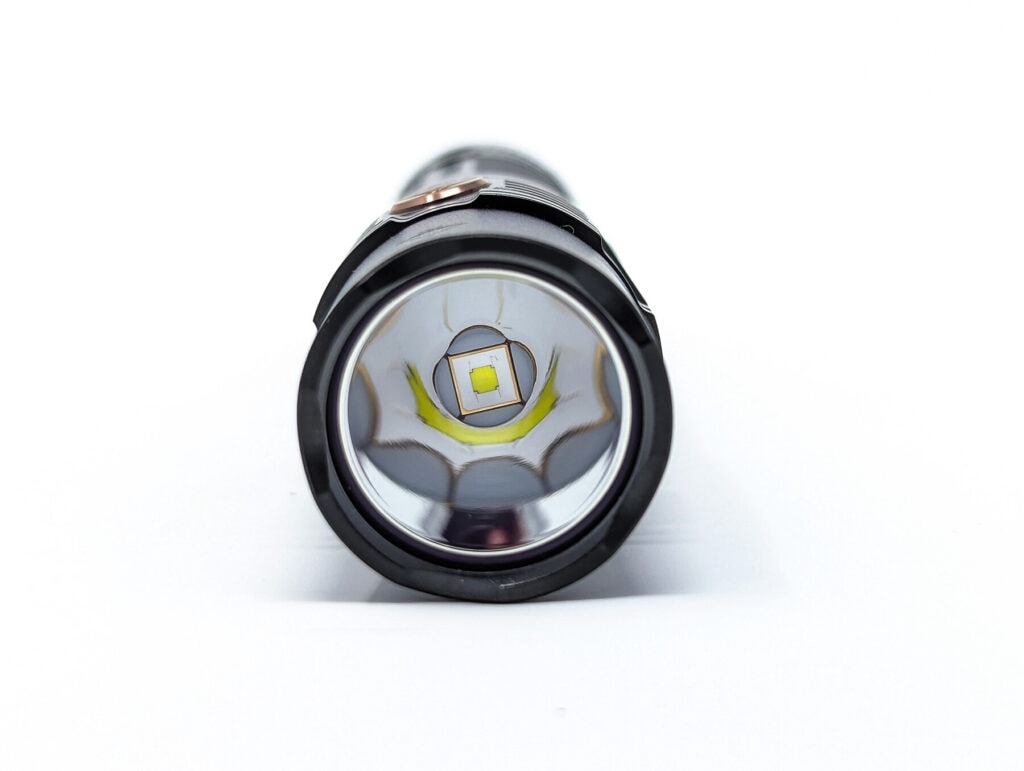
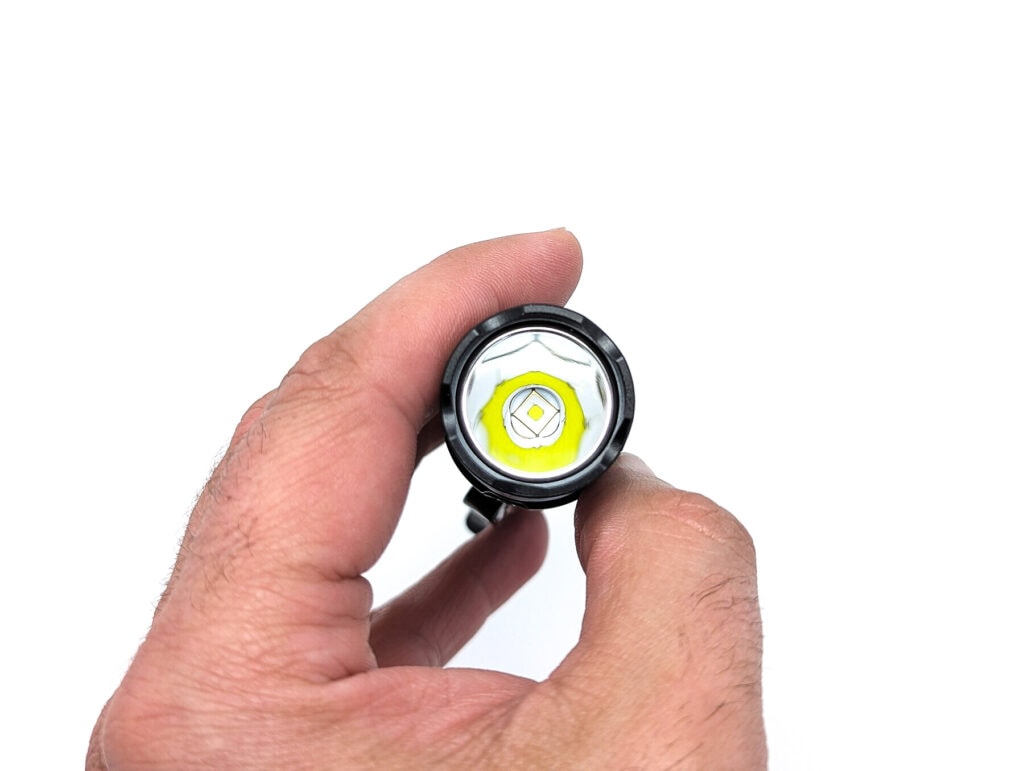
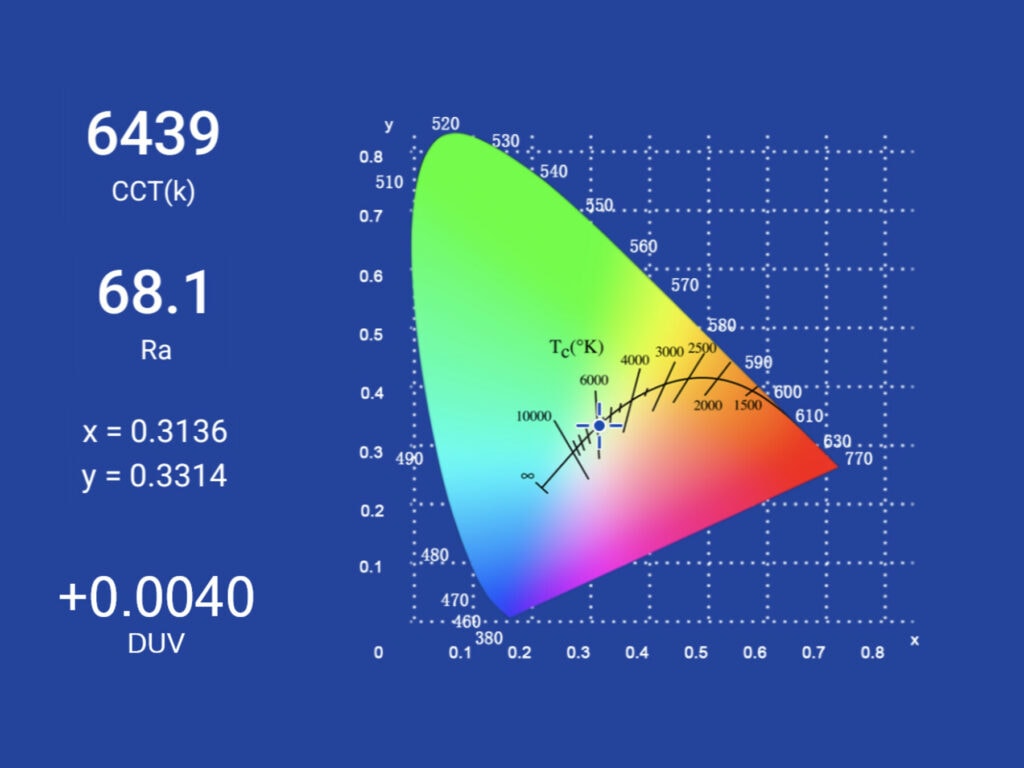
Dimensions and its competition
Dimensions:
| Fenix PD36R v2.0 | Millimeters | Inches |
|---|---|---|
| Length | 141 mm | 5.5 in |
| Head diameter | 27 mm | 1.0 in |
| Body diameter | 26 mm | 1.0 in |
Dimensions are rounded to the nearest millimeter and the nearest tenth of an Inch.
Weight:
| Fenix PD36R v2.0 | Weight in grams | Weight in oz |
|---|---|---|
| Without battery: | 94 g | 3.3 oz |
| With battery | 165 g | 5.8 oz |
Weight is rounded to the nearest gram and tenth of an Oz.
Flashlight size comparison with its competition:
Group 1 Fenix flashlights: Fenix LD12R, Fenix LD30R, Fenix PD36R V2.0
Group 2: Olight Baton 3 Pro Max, Fenix PD36R v2.0, Acebeam E75
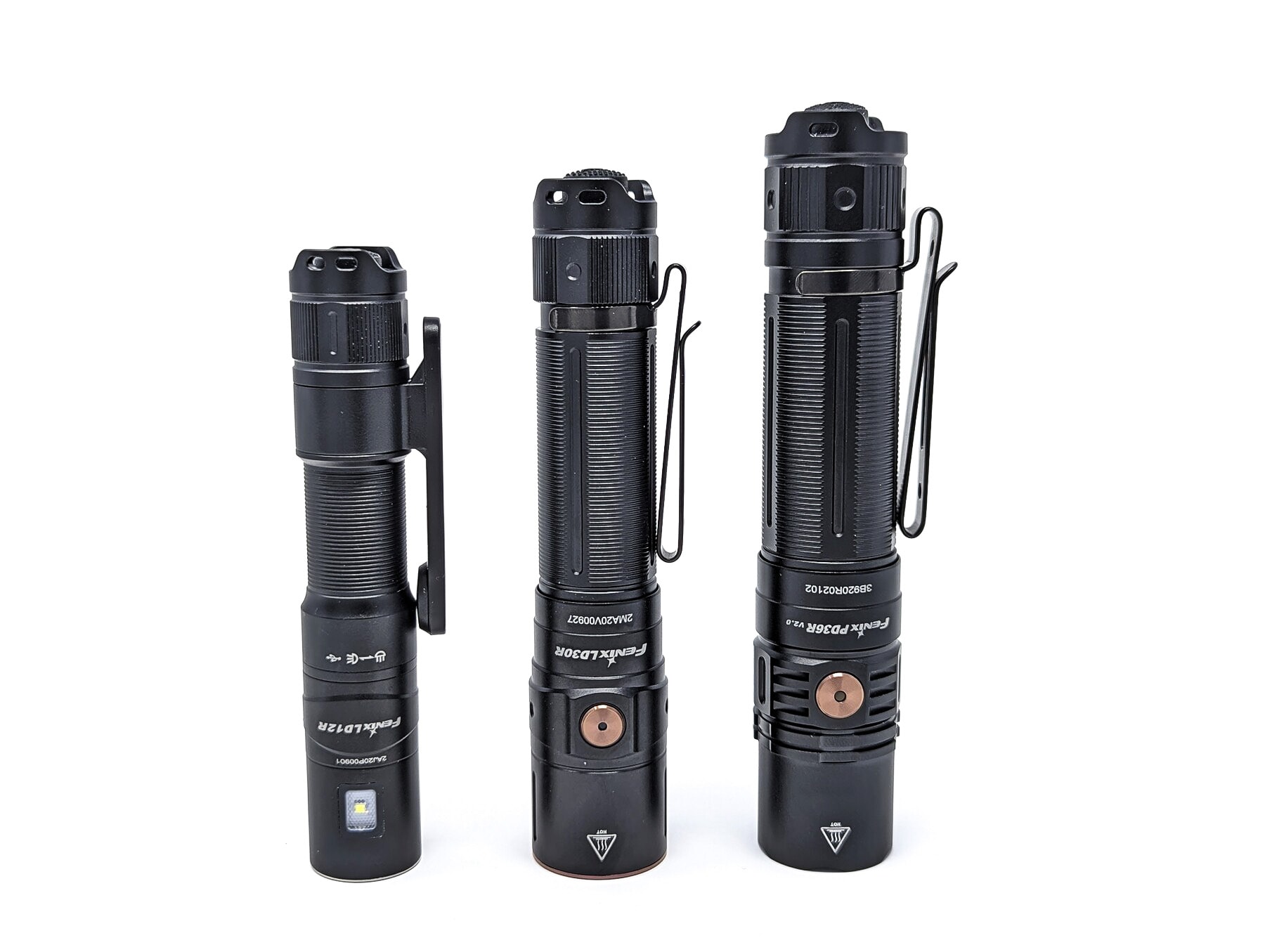
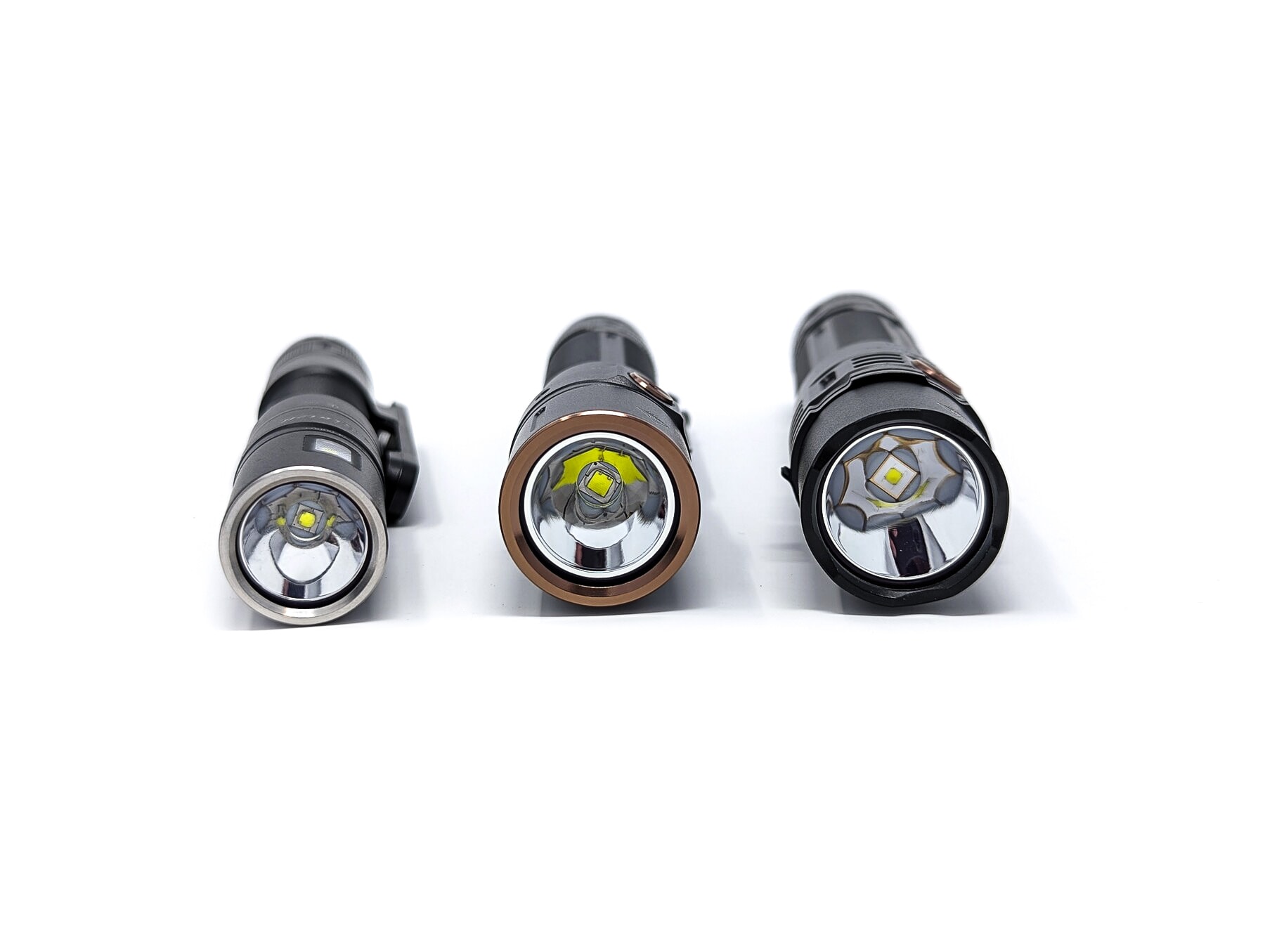
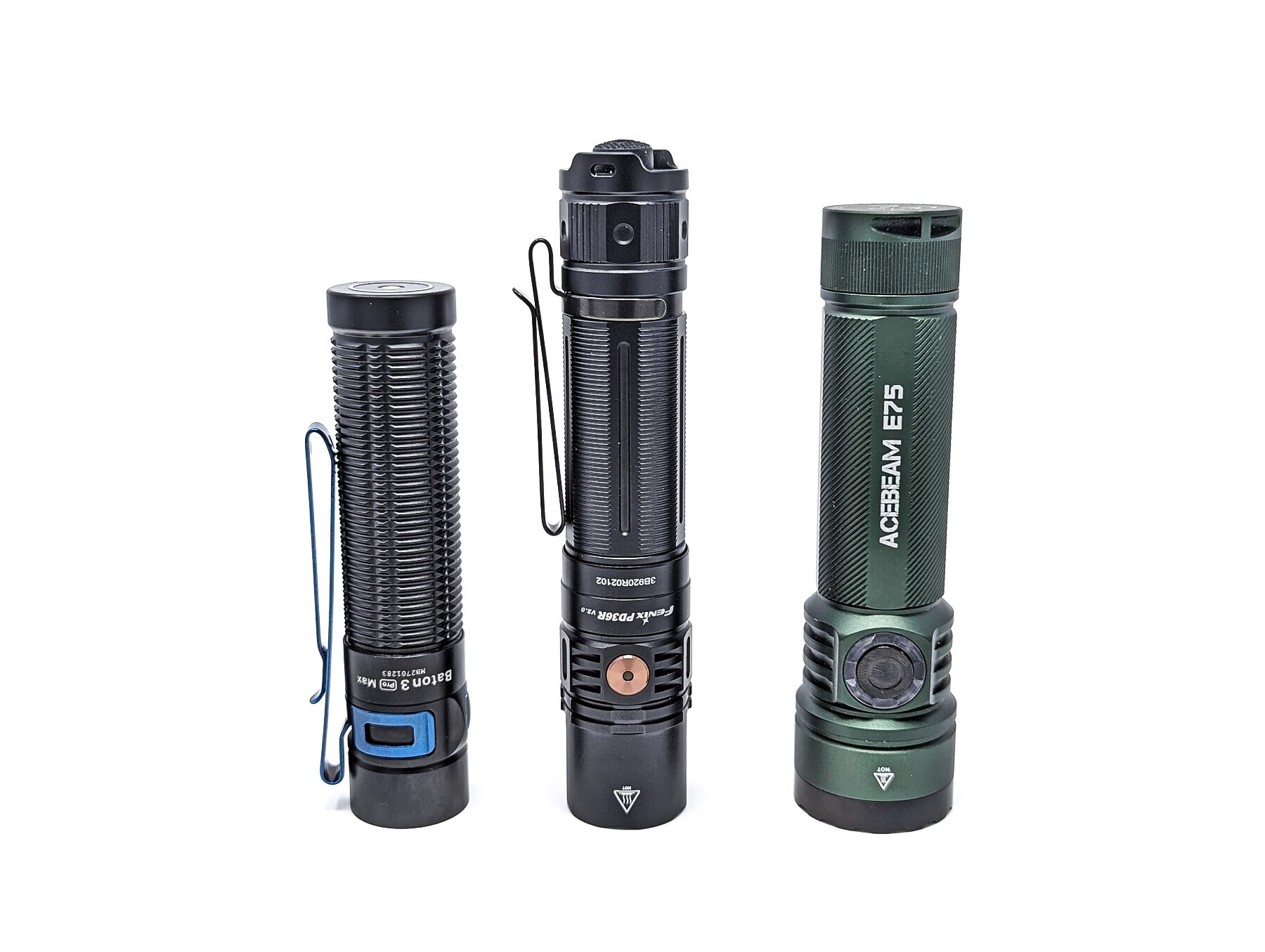
Fenix PD36R v2.0 UI: User Interface and Driver
Fenix refers to the tail switch as the “tactical switch” and the side e-switch as the “functional switch.” Generally speaking, the tail switch is solely for on/off/momentary and the side switch is for mode switching.
Available modes:
- Eco, Low, Medium, High, Turbo
Available blinky modes:
- Strobe
From OFF:
- Tactical Switch, Press and hold: momentary on
- Tactical Switch, Single click: on
From ON:
- Tactical Switch, Single click: off
- Functional Switch, Press and hold 0.5 sec: Strobe
- Functional Switch, 1 click: change modes (Eco > Low > Med > High > Turbo)
Mode memory:
- Yes, any mode can be memorized except for Strobe
Shortcuts:
- To Low: N/A
- To Turbo: N/A
- To Strobe: press and hold 0.5 sec from On
Low voltage warning/protection:
- When you turn on the flashlight, an indicator in the middle of the side switch illuminates for 3 seconds to display the battery status:
- Green, constant: between 100% and 85%
- Green, flashing: between 85% and 50%
- Red, constant: between 50% and 25%
- Red, flashing: between 25% and 1%
Strobe/blinkies
- Strobe: press and hold 0.5 sec from On
Lock-out mode:
- N/A
PWM
- There is no PWM
Additional/summary info on the UI:
- There is “intelligent overheat protection” that reduces output to keep the temperature at or below 60° C
Fenix PD36R v2 Charging and batteries
The PD36R V2.0 comes with a Fenix-branded cell, the ARB-L21-5000 V2.0. It is not a proprietary battery, just a button-top 5000 mAh 21700 battery with a protection circuit. I tried a flat-top Samsung 40T battery and it was too short to make contact – that, or the physical reverse polarity protection (which relies on a button-top battery) was preventing contact.
A solder-blobbed 40T worked, a bit to my surprise. The 40T was certainly shorter than Fenix’s protected battery, and with there only being a tail spring (the head has a flat contact), I was concerned that even the solder-blobbed 40T would be too short – but I’m happy to report that it worked.
The Fenix PD36R V2.0 has built-in USB-C charging via a port on the side of the head which is covered up by a typical rubber dust plug. Fenix says that a fully depleted battery should take 2.5 hours to recharge when using a 18W or higher-power fast charging adapter. While charging, the indicator LED will illuminate red, then switch to green when charging is complete. In my testing, I observed a 13.2 watt charge rate (1.48A at 8.94V) and the cycle completed in 2 hours 19 minutes.
| Charge type | Fits | No fit | Charge time |
|---|---|---|---|
| Flashlight with onboard USB-C | Button-top 21700 batteries | Flat-top 21700 batteries | 2h 19min |
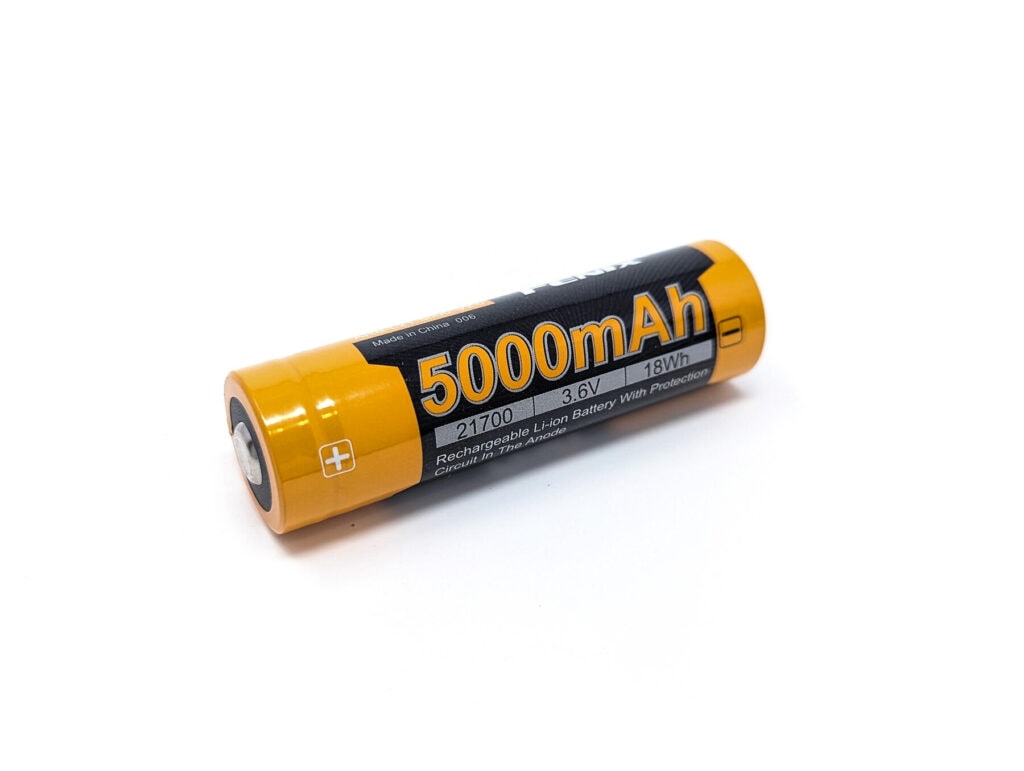
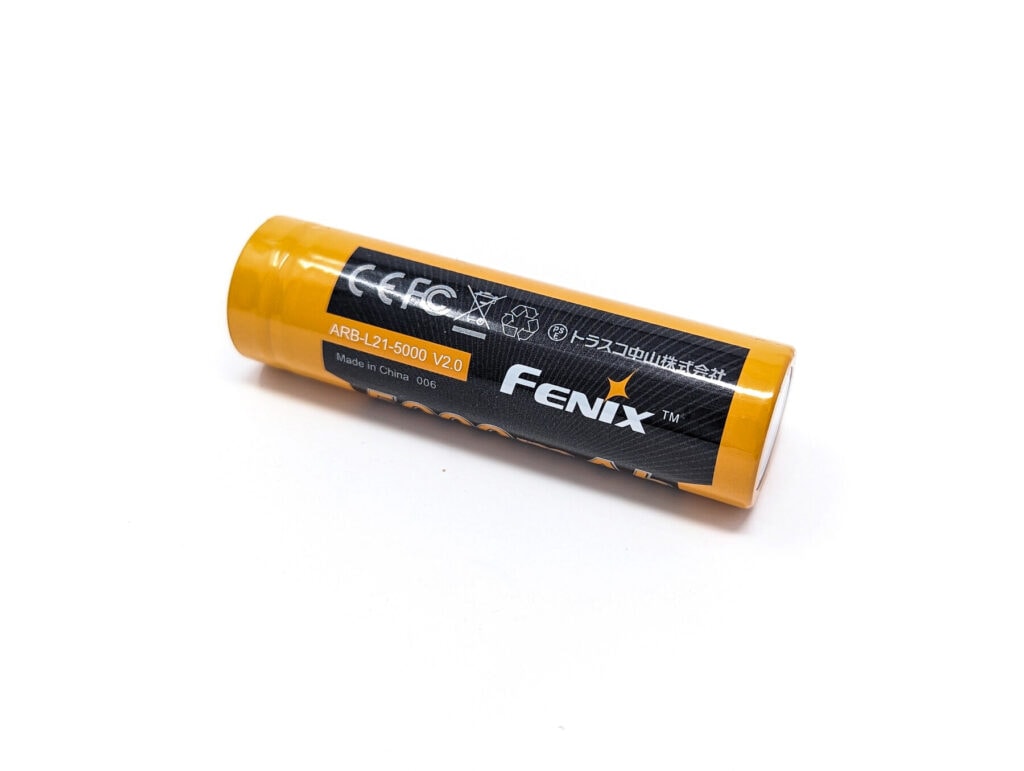
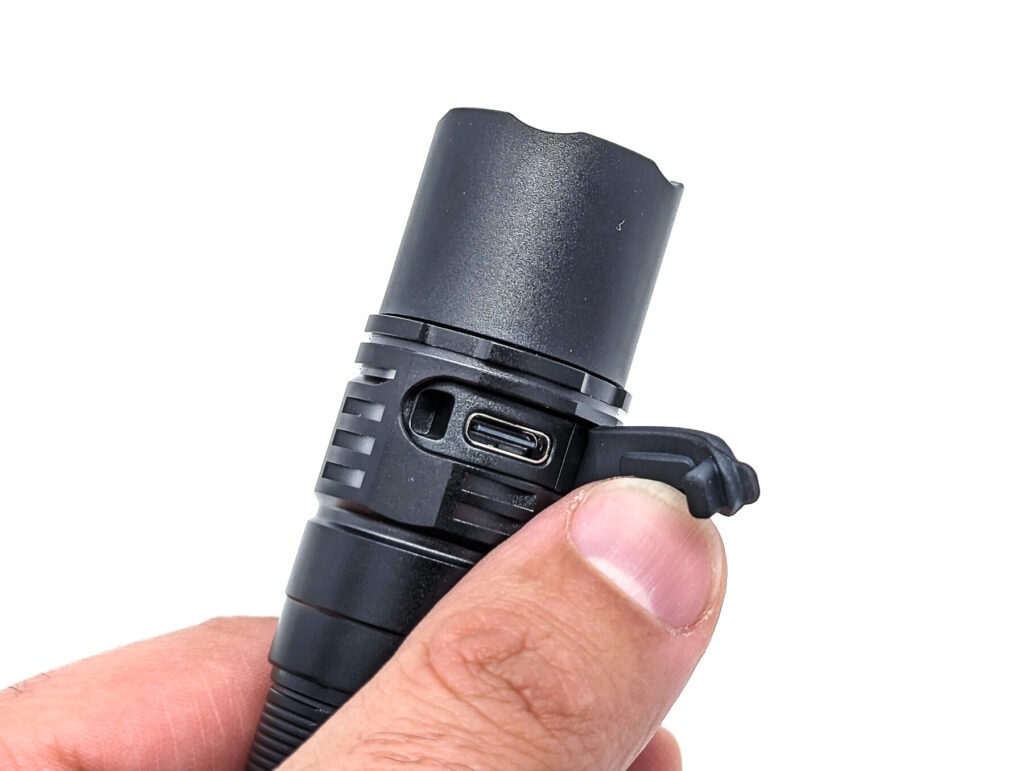
Performance test
Lumen measurements
How Lumens are Measured: Understanding ANSI FL1 Standards How Lumens are Measured: Understanding ANSI FL1 Standards: The ANSI FL1 standards specify that output in lumens should be measured 30 seconds after turning on, as this is the standardized time for measuring brightness according to the industry standard. This is why we focus on this part in our measurements. The ANSI FL1 standards require an ambient temperature of 22 ± 3°C. We record the ambient the ambient temperature to identify potential reasons for any observed discrepancies.Lux was measured by a UNI-T UT383 BT at 5 meters. Lumens were measured in a homemade lumen tube using a VEML7700 sensor, calibrated with a calibration light provided by 1Lumen. The included Fenix battery was used in the tests.
| Mode | Amps at start | Specified | 0 sec. | 30 sec. | 10 min. |
|---|---|---|---|---|---|
| Eco | 13 mA | 5 lm | 5 lm | 5 lm | – |
| Low | 93 mA | 50 lm | 49 lm | 49 lm | – |
| Med | 625 mA | 350 lm | 412 lm | 409 lm | 406 lm |
| High | 1.8 A | 800 lm | 956 lm | 943 lm | 915 lm |
| Turbo | 5.2 A | 1700 lm | 2092 lm | 1924 lm | 702 lm |
| Turbo at 3.6V | 3.2 A | 1322 lm | 1319 lm |
Parasitic drain:
- N/A – clicky switch doesn’t have parasitic drain
The Fenix PD36R V2.0 performed admirably in my tests. It exceeded the lumen specs, and the ramp-down in Turbo mode was smooth, waiting around 1 ½ minutes before beginning to ramp down, and then taking 2 minutes to gradually reduce the output. And High mode was able to hold more than 900 lumens for 15 minutes before ramping down, without getting anywhere near uncomfortably warm. Sure, 2000 lumens isn’t anything earth-shattering, but I appreciate that the PD36R V2.0 has realistic output that isn’t going to cause near-instant decreases in output.
Fenix PD36R v2 Battery Life: Runtime graphs
How Runtimes are Measured: Understanding ANSI FL1 Standards About ANSI FL1 runtime standards: The runtime is measured until the light drops to 10% of its initial output (30 seconds after turning on). This does not mean that the flashlight is not usable anymore. The last column shows how long the light actually works till it shuts off. If there is a + symbol, it means that the test was stopped at that particular point, but the light was actually still running. This happens on certain occasions, with certain drivers, firmware, or batteries.| Mode | Specified | Measured runtime ANSI | Time till shut off |
|---|---|---|---|
| Eco | 482h | – | – |
| Low | 50h | – | – |
| Med | 7h 45min | 7h 27min | 12h 34min+ |
| High | 4h 15min | 4h 10min | 7h 24min+ |
| Turbo | 3h 30min | 3h 20min | 7h 24min+ |
There’s no surprises here – my tests are very close to Fenix’s specs. I will say that after the light stepped down to Eco mode because of the low battery, it kept on going for hours and hours and I eventually stopped the tests. It chugged along at 5-6 lumens for a very long time. I was initially concerned about the battery being run down too low, but when I checked it, the battery was still at 2.98V even after running at 5-6 lumens for 3+ hours.
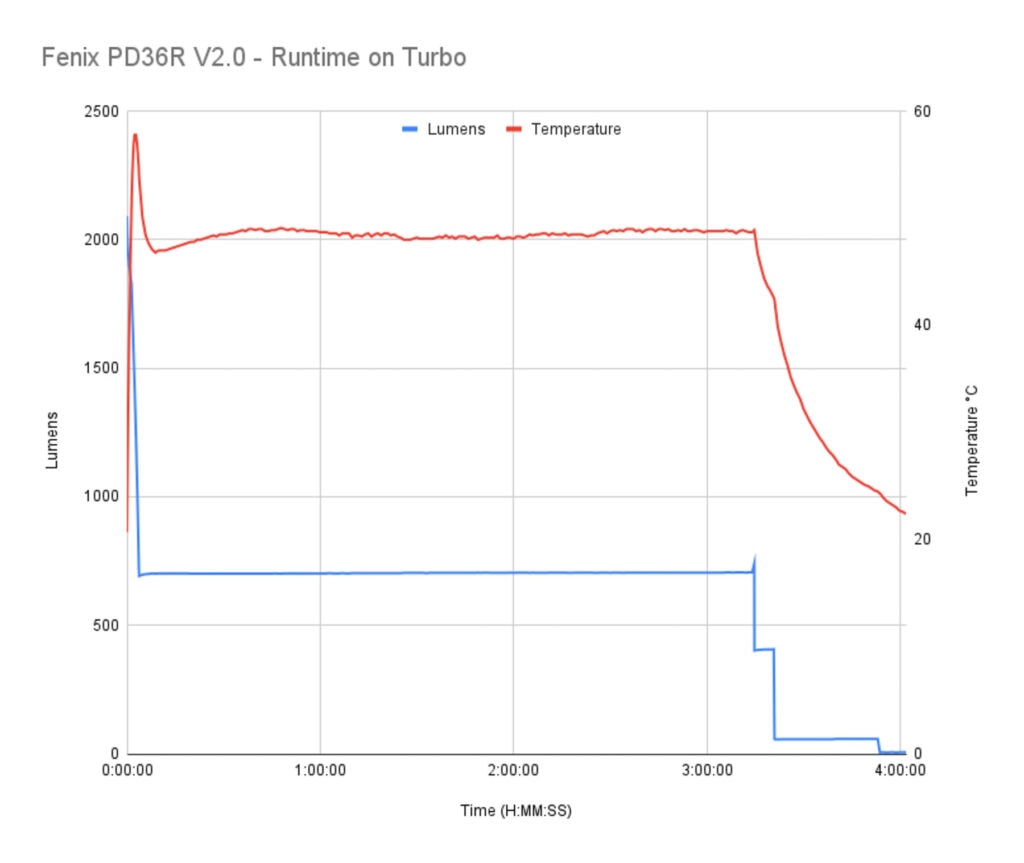
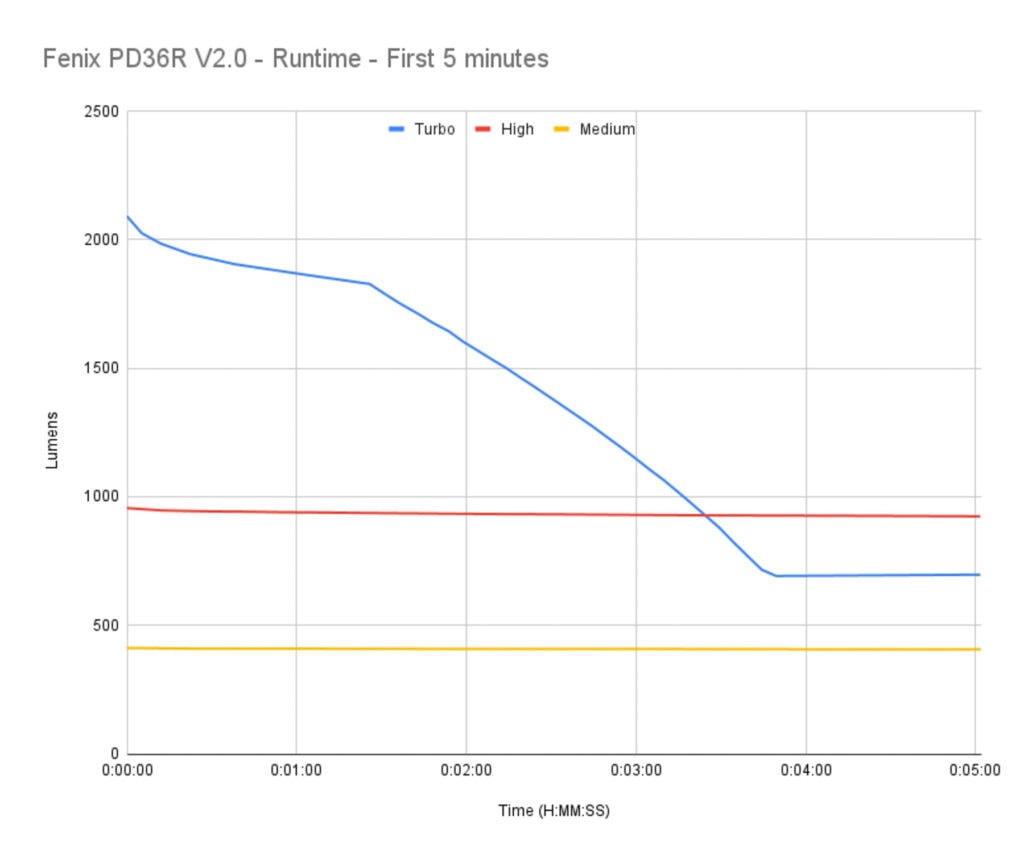
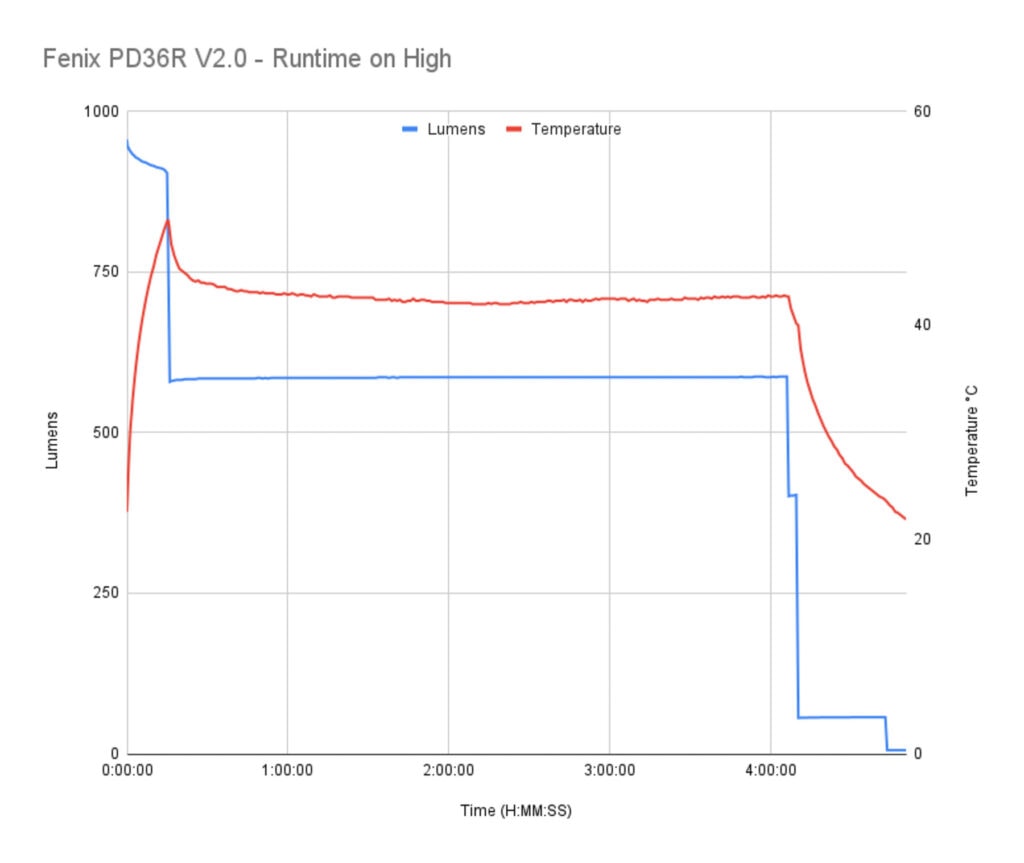
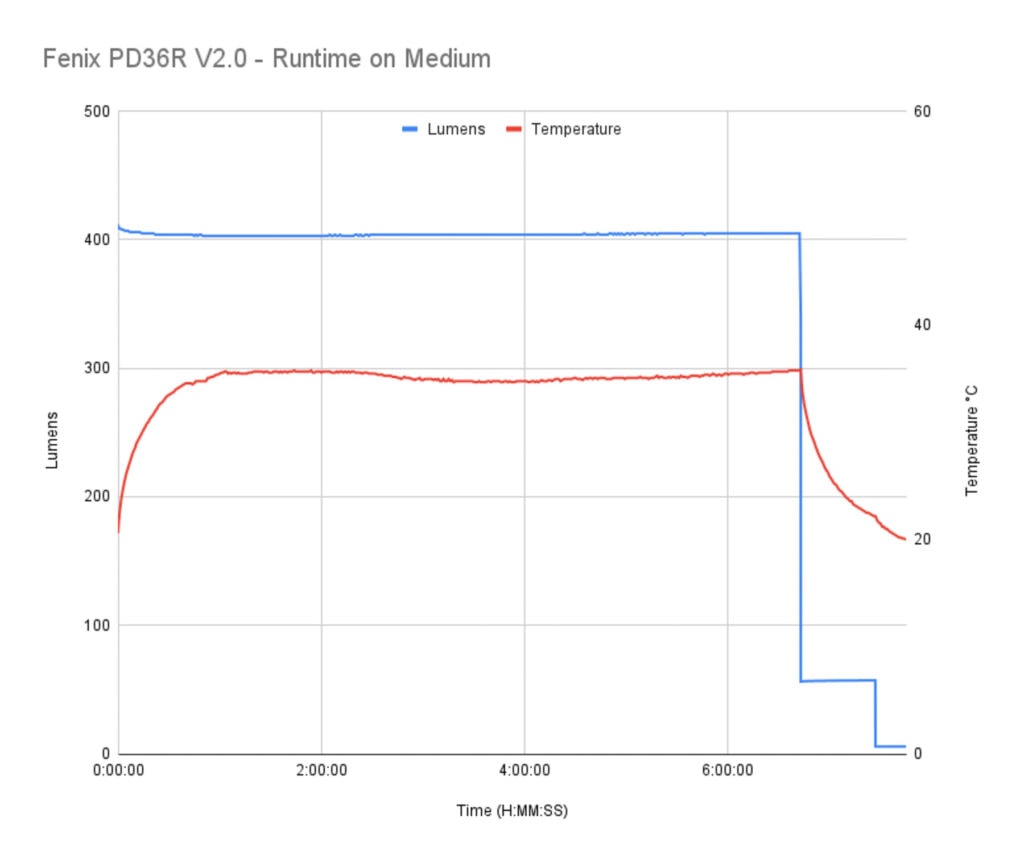
Peak beam intensity and beam distance measurements
About Peak beam intensity: Understanding ANSI FL1 Standards About peak beam intensity The calculated value of distance in meters at which the flashlight produces a light intensity of 0.25 lux. (0.25 lux is about the brightness of a full moon shining on an object). This means that the intensity has decreased so much, it becomes difficult to see darker objects, or objects that don’t reflect light. The columns ‘Meters’ and ‘Yards’ use rounded numbers.Intensity was measured at 5 meters after being turned on for 30 seconds. A UNI-T UT383 BT lux meter was used.
| Mode | Specified | Candela measured | Meters | Yards |
|---|---|---|---|---|
| Eco | 89 cd | – | – | – |
| Low | 1,107 cd | 1,100 cd | 66 m | 73 yd |
| Medium | 7,809 cd | 7,900 cd | 178 m | 194 yd |
| High | 18,016 cd | 18,275 cd | 270 m | 296 yd |
| Turbo | 39,240 cd | 39,575 cd | 398 m | 435 yd |
I’m not sure I’ve ever gathered intensity test results that were this close to the manufacturer’s specs. These measurements were within 1%. A side note… 40kcd isn’t going to set any records, but I’d say it is very respectable for this being a tube light.
Beamshots
Beam shots of the building are taken at 30 m (33 yd) using a Pixel 7 set to ISO 800 with 1/10 second exposure time
Beamshots of the following flashlights compared:
- Fenix PD36R V2.0
- Maratac / Acebeam Defender P16
- Fenix PD36R Pro
- Olight Baton 3 Pro Max
Please note that the following beamshots are mainly intended to showcase the beam pattern and beam quality, rather than overall performance. These images are typically taken directly after activation, and in different seasons or weather conditions, and therefore do not fully represent its overall performance. For accurate performance metrics, such as output, beam distance, and runtimes, you need to look at the performance section of this review.
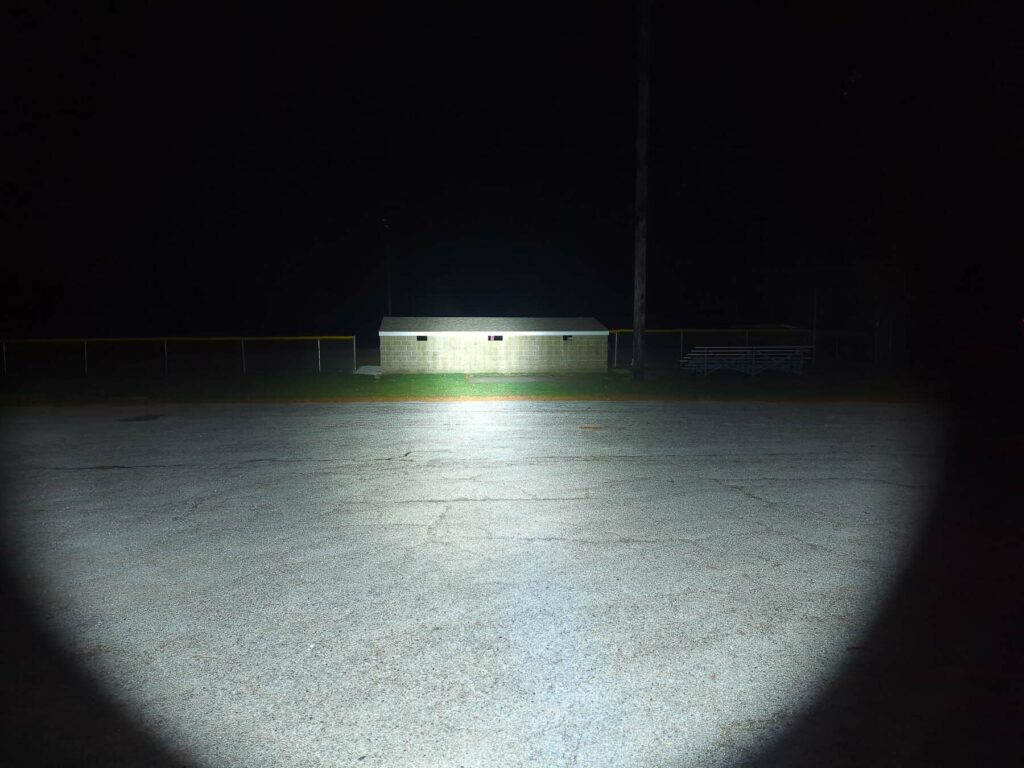

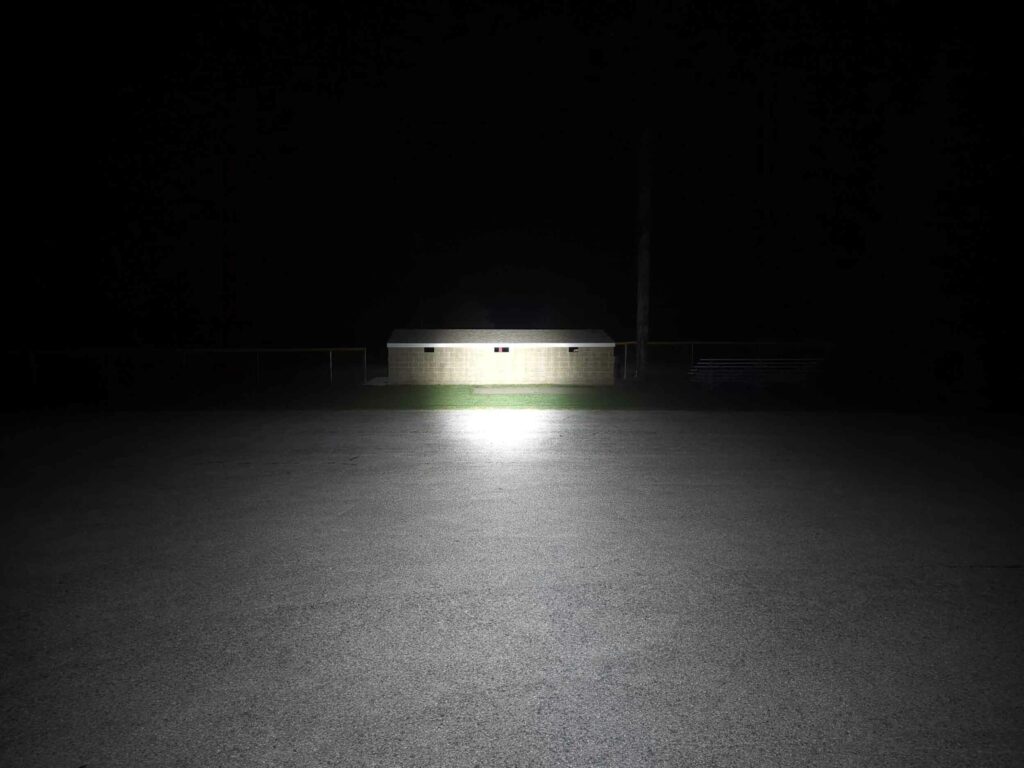

Disclaimer: This flashlight was sent to us for review at no cost by Fenix Lighting USA. We have not been paid to review, nor have we been holding back on problems or defects.
Final Verdict
Pros
- Great build quality
- Clean, strong beam (for its size)
- Excellent regulation
- USB-C charging
- Easy dual-switch UI
Cons
- No UI shortcuts
- Side switch can be difficult to find
Explanation on star ratings:
1: Avoid: a match would be a better choice – 2: Poor: significant defect or issues; almost unusable – 3: Average: some defects or issues; but still usable 4: Good: recommended (minor issues) – 5: Great: highly recommended

4.5 stars: ★★★★⋆
While our star rating provides a reliable indicator, we encourage you to read the full review to make an informed decision based on your own needs and preferences.
If I’m being perfectly honest with myself, most of my flashlights that I have out and available are more for show than anything. Either they were fun to build, or they have fancy aux lighting, or they have just the right CCT and tint. Those are nice and all, but I put them in a completely different category than what you see with the Fenix PD36R V2.0.
It isn’t designed to be fun or flashy; it’s a work tool through and through. From the great build quality and warranty, to the included holster, the simple user interface, and the high-output and no-nonsense SFT40 LED, it’s clear to see that Fenix made the PD36R V2.0 to be a workhorse. And I’d say they nailed that objective.
Buy your Fenix PD36R v2.0 with a discount
Get 10% off every purchase at Fenix Lighting US, by using our exclusive 1lumen discount code: 1lumen10
1lumen selects and reviews products personally. We may earn affiliate commissions through our links, which help support our testing.